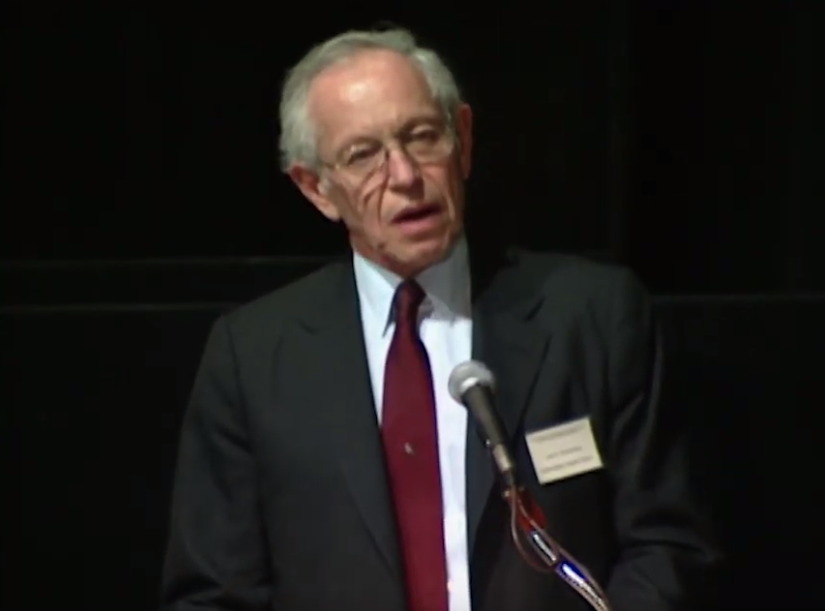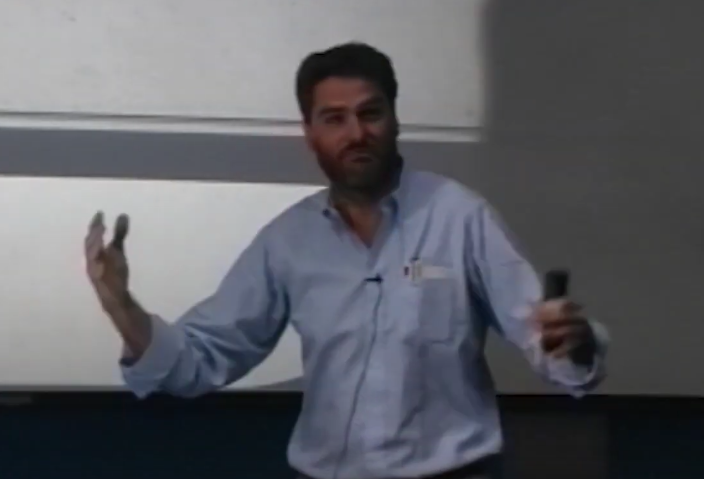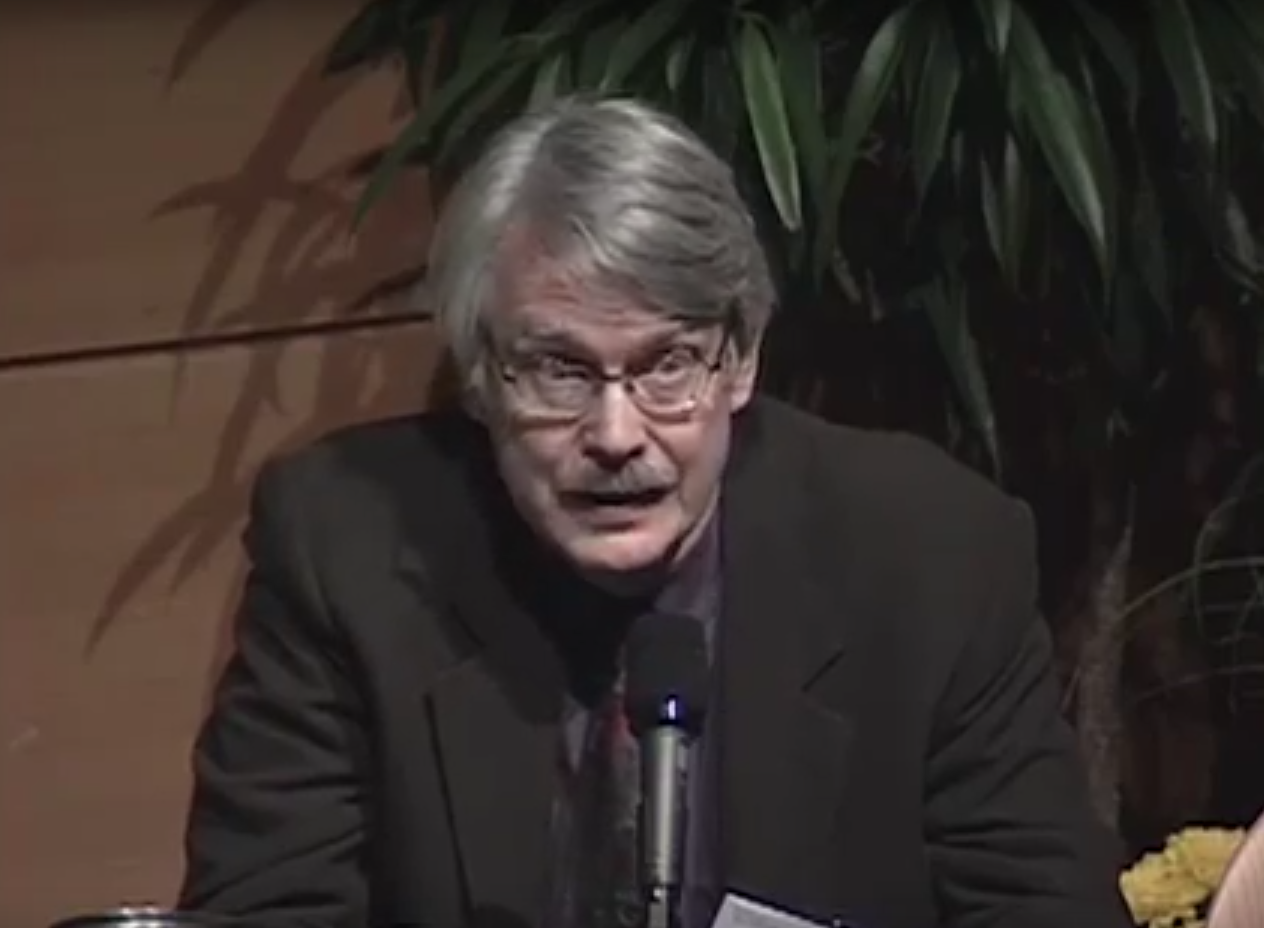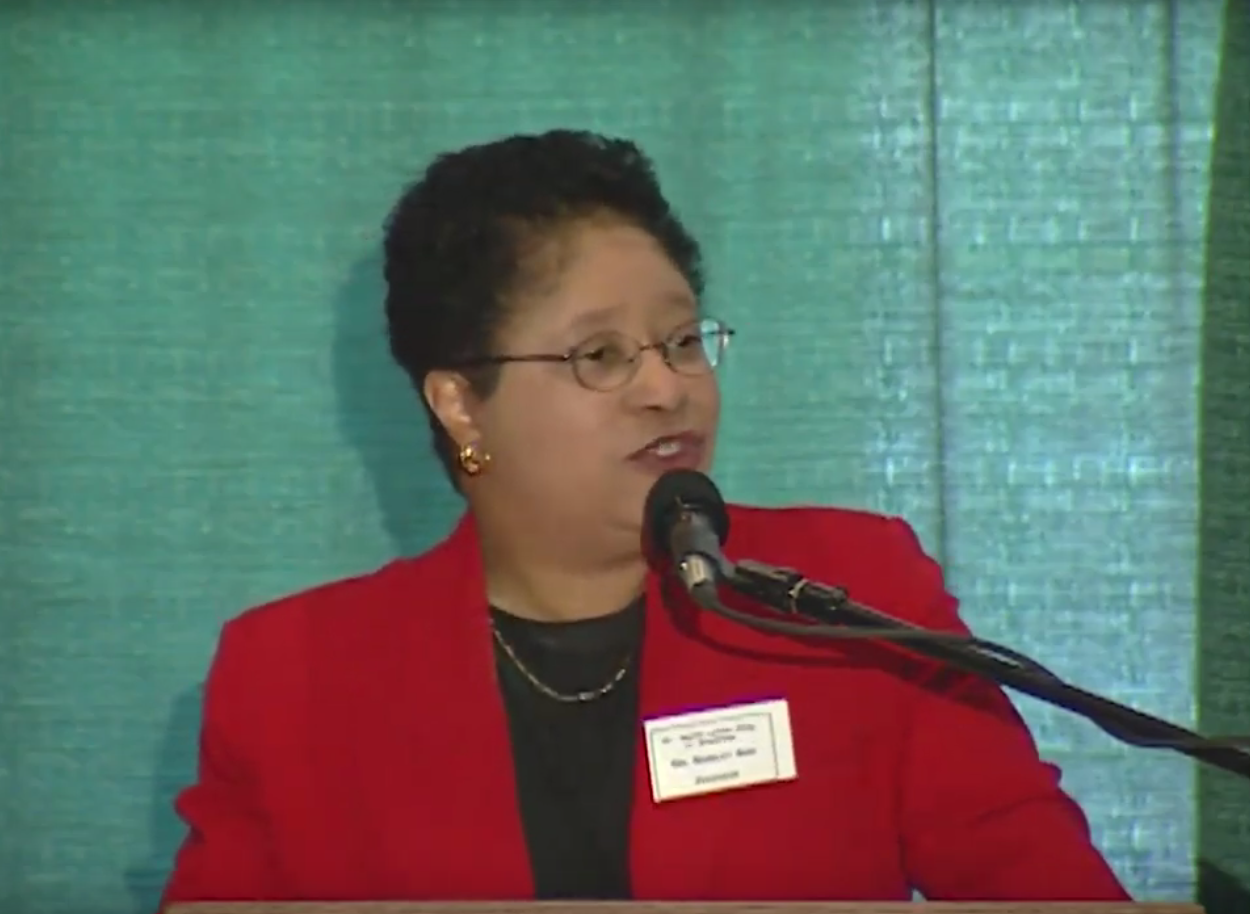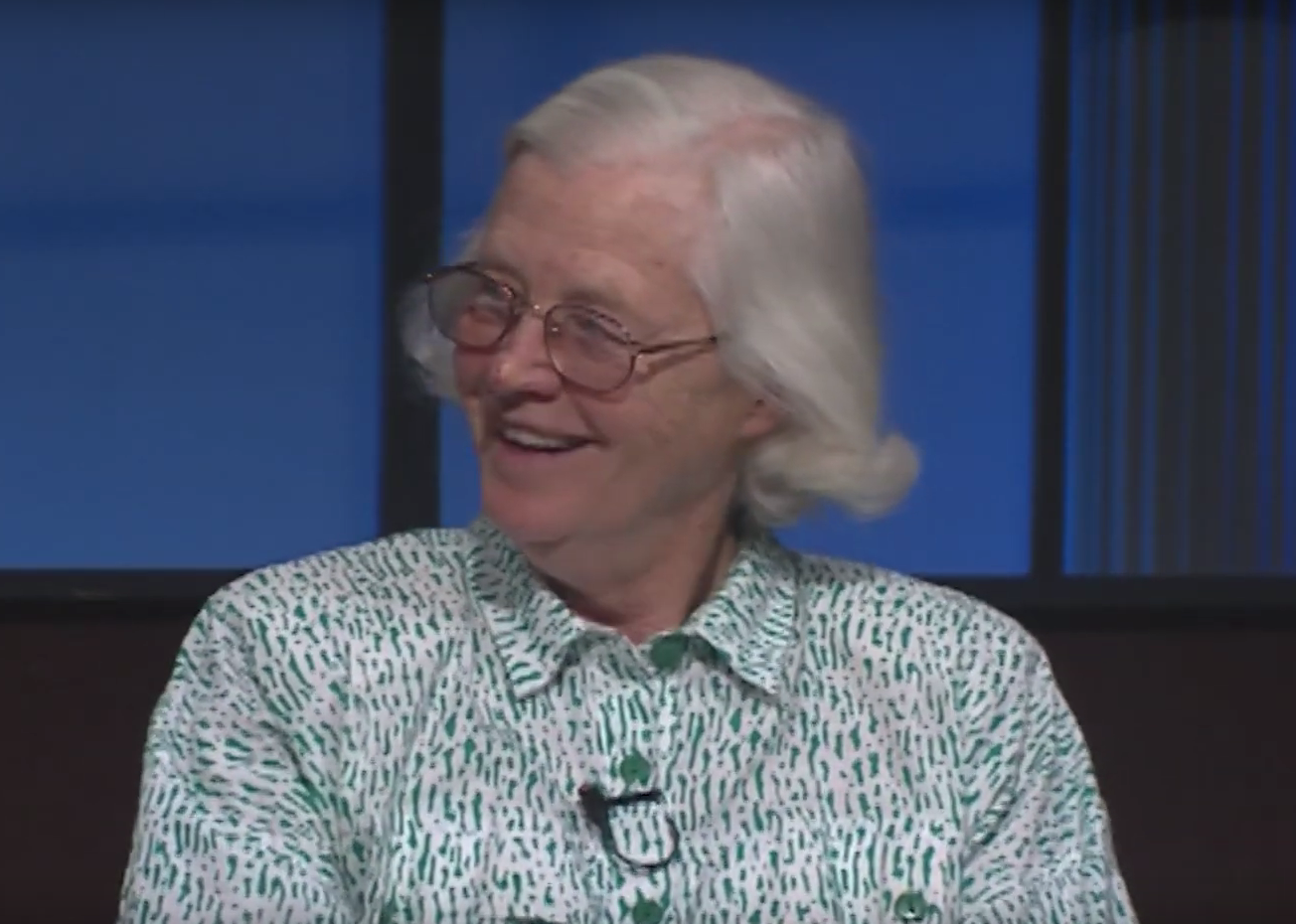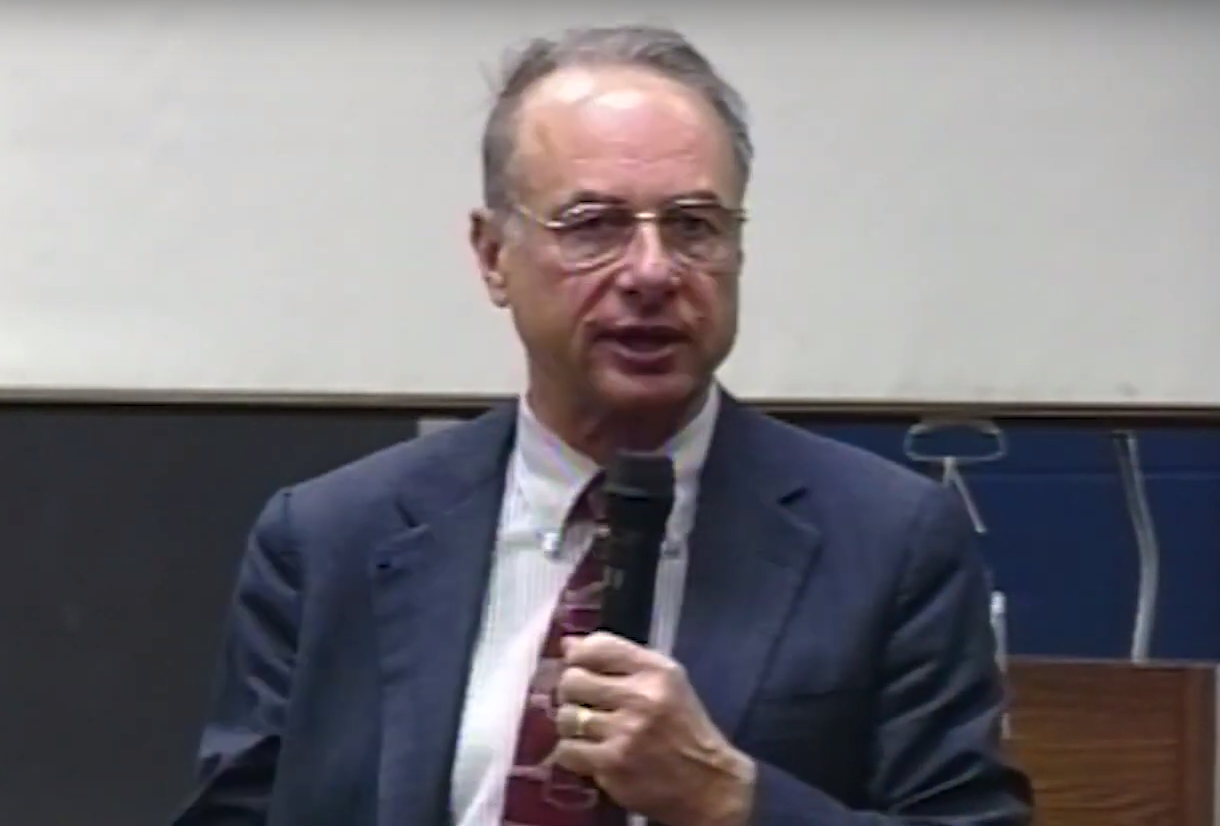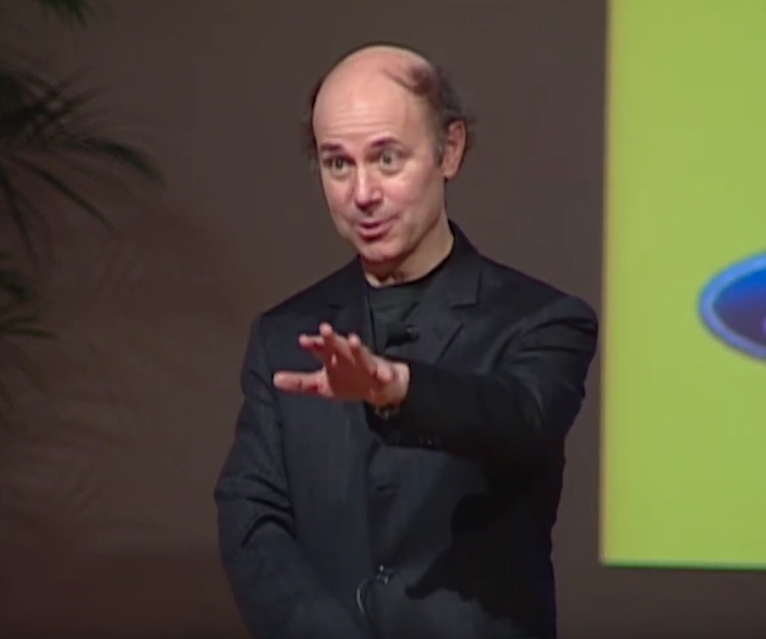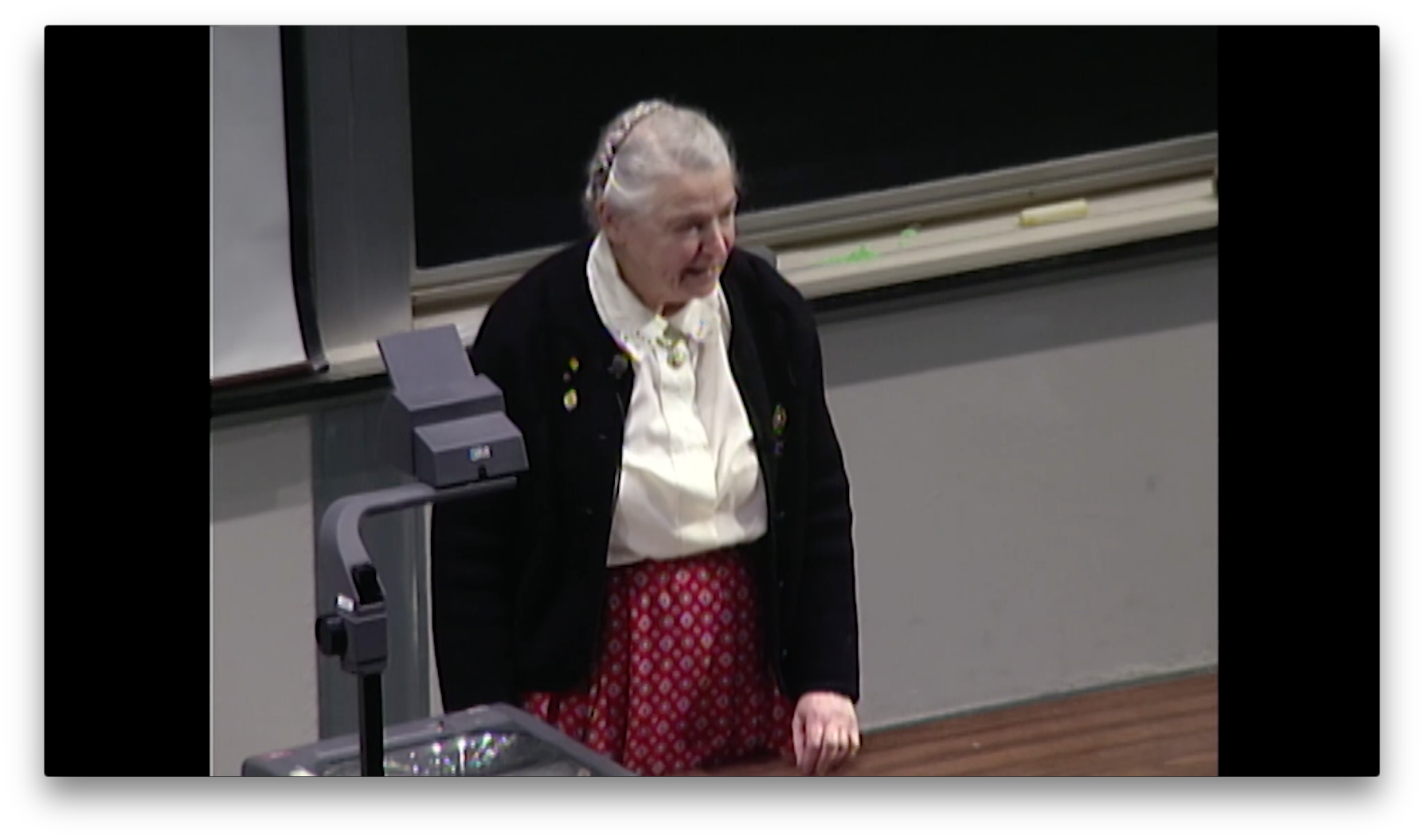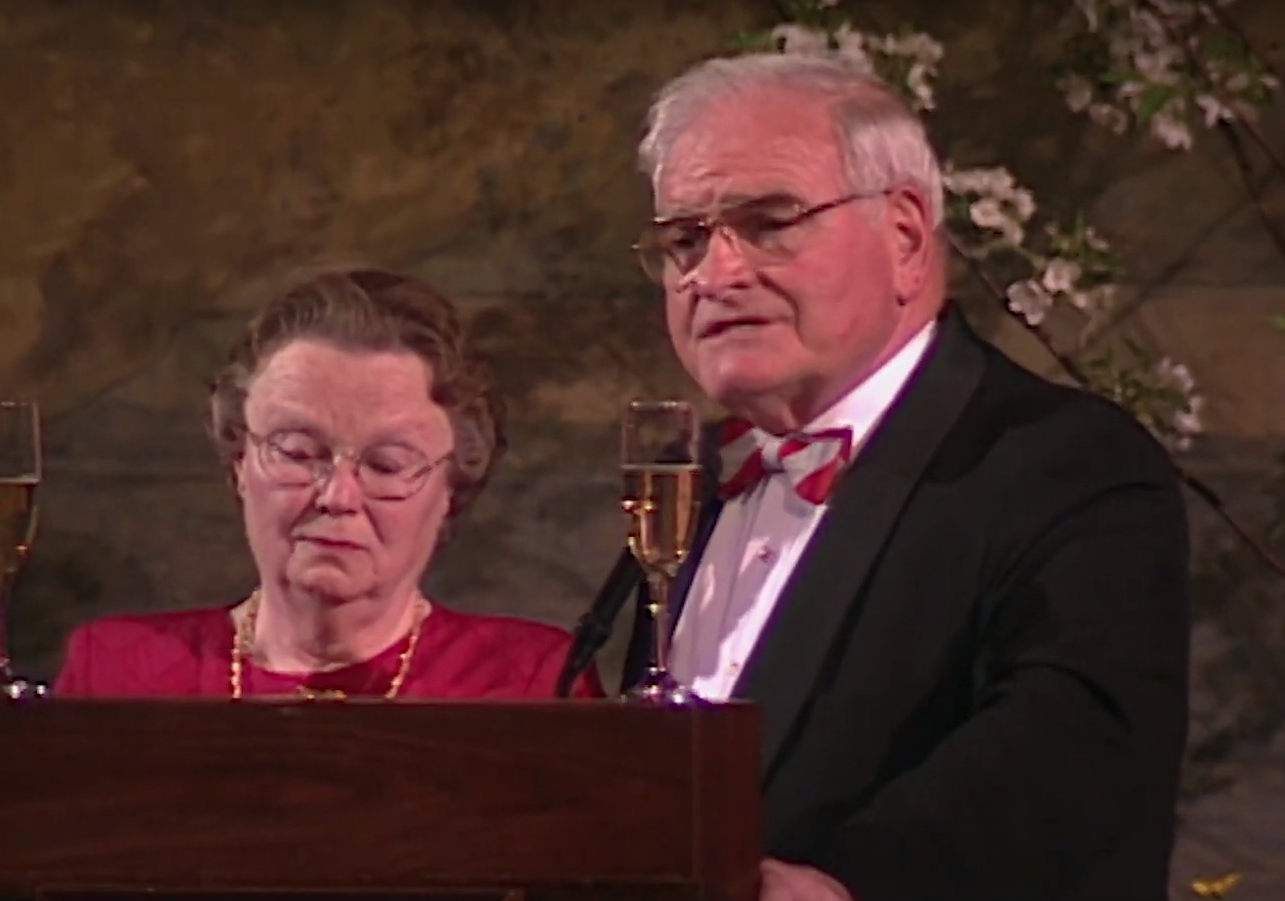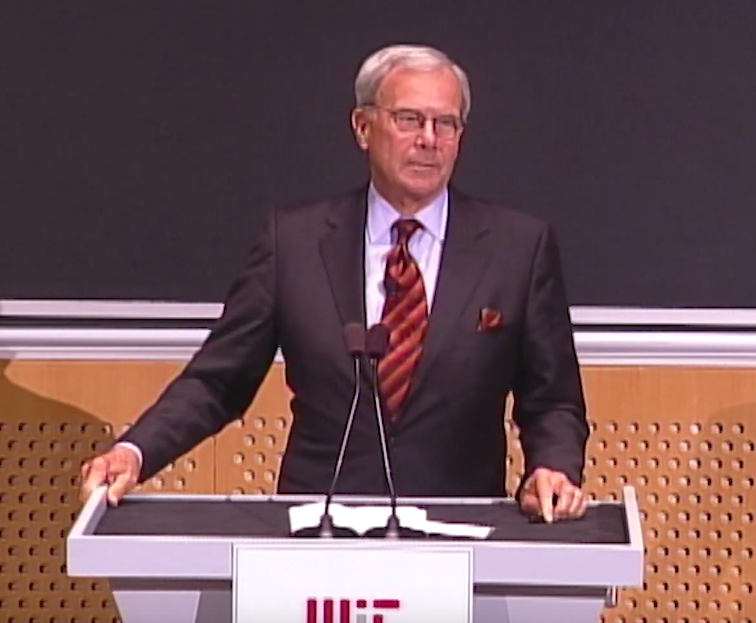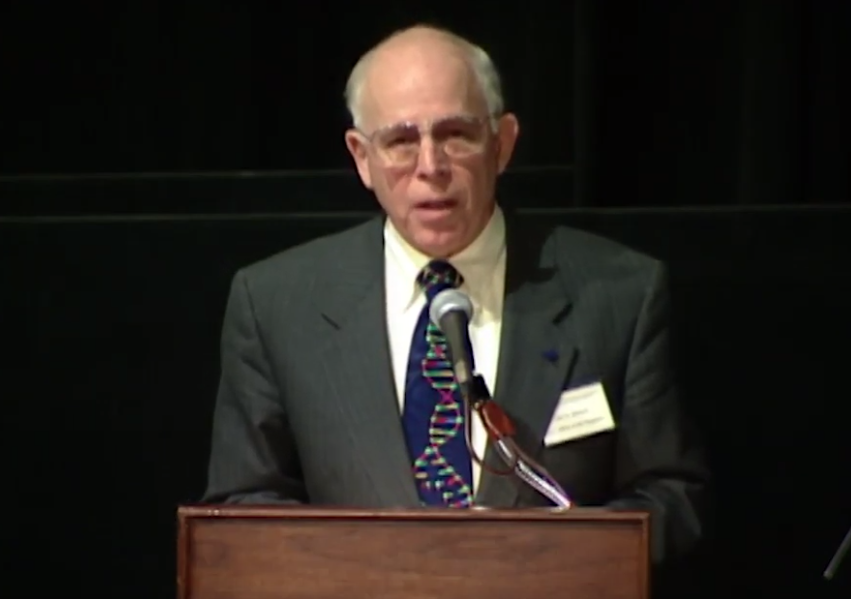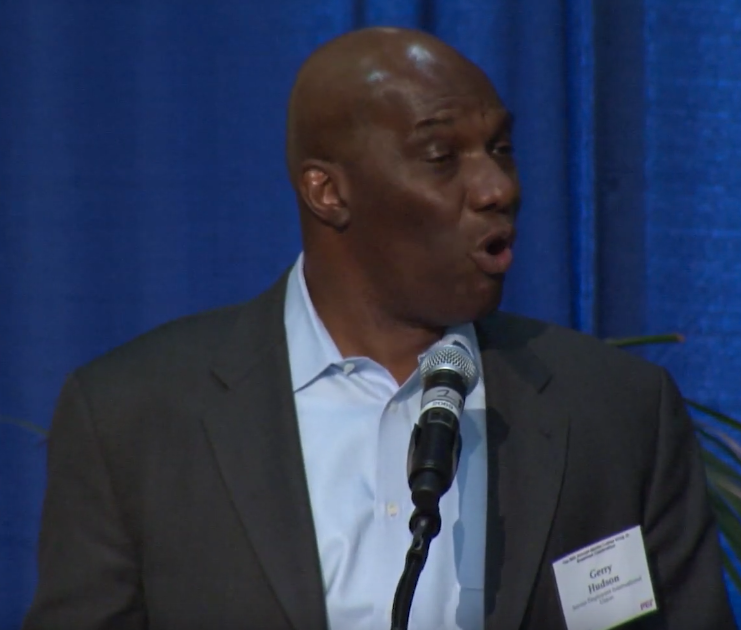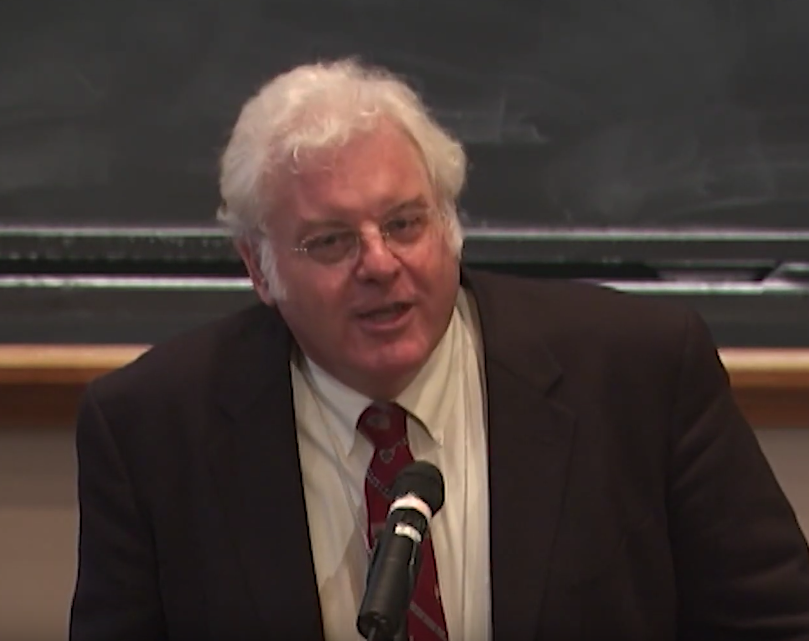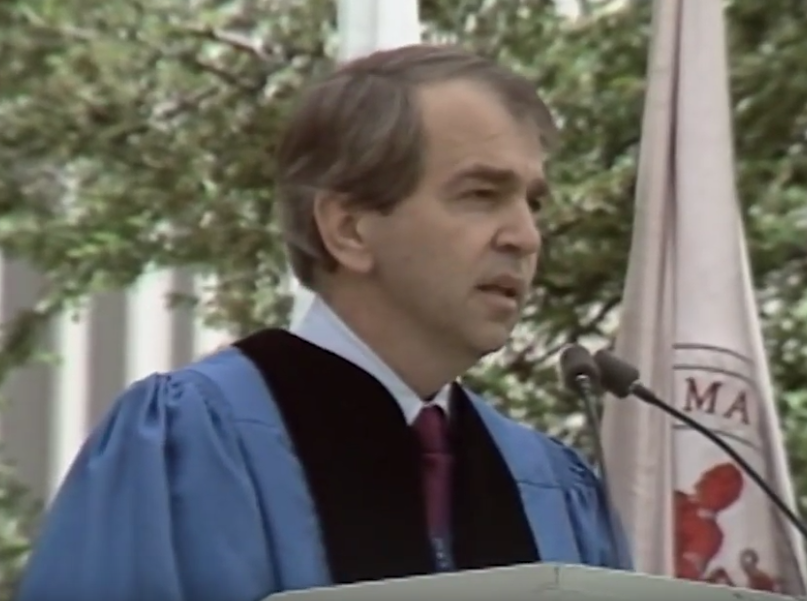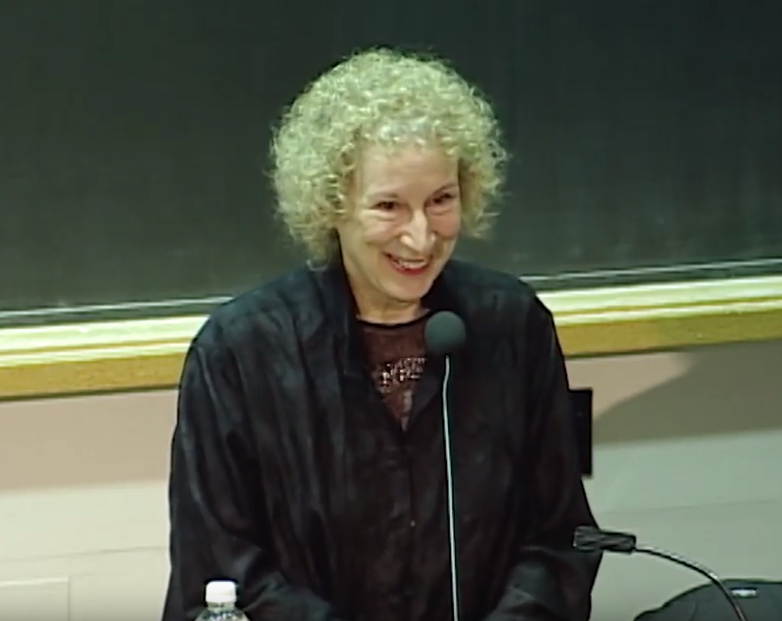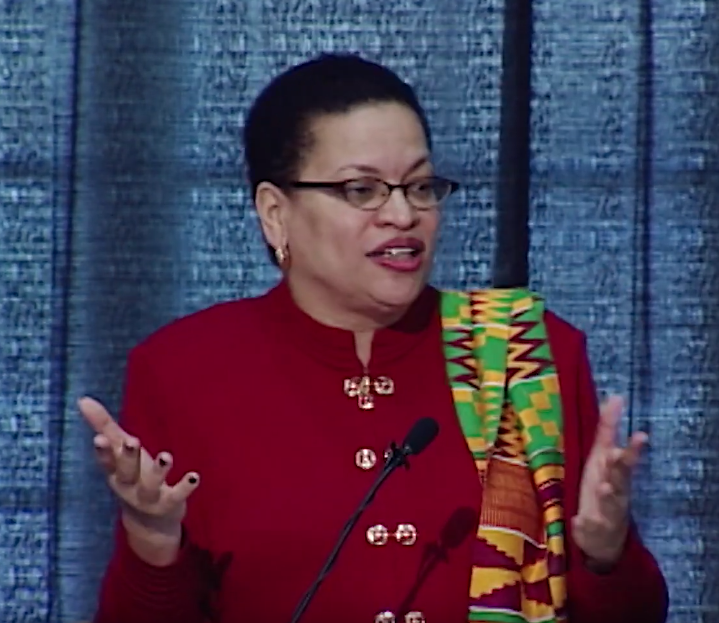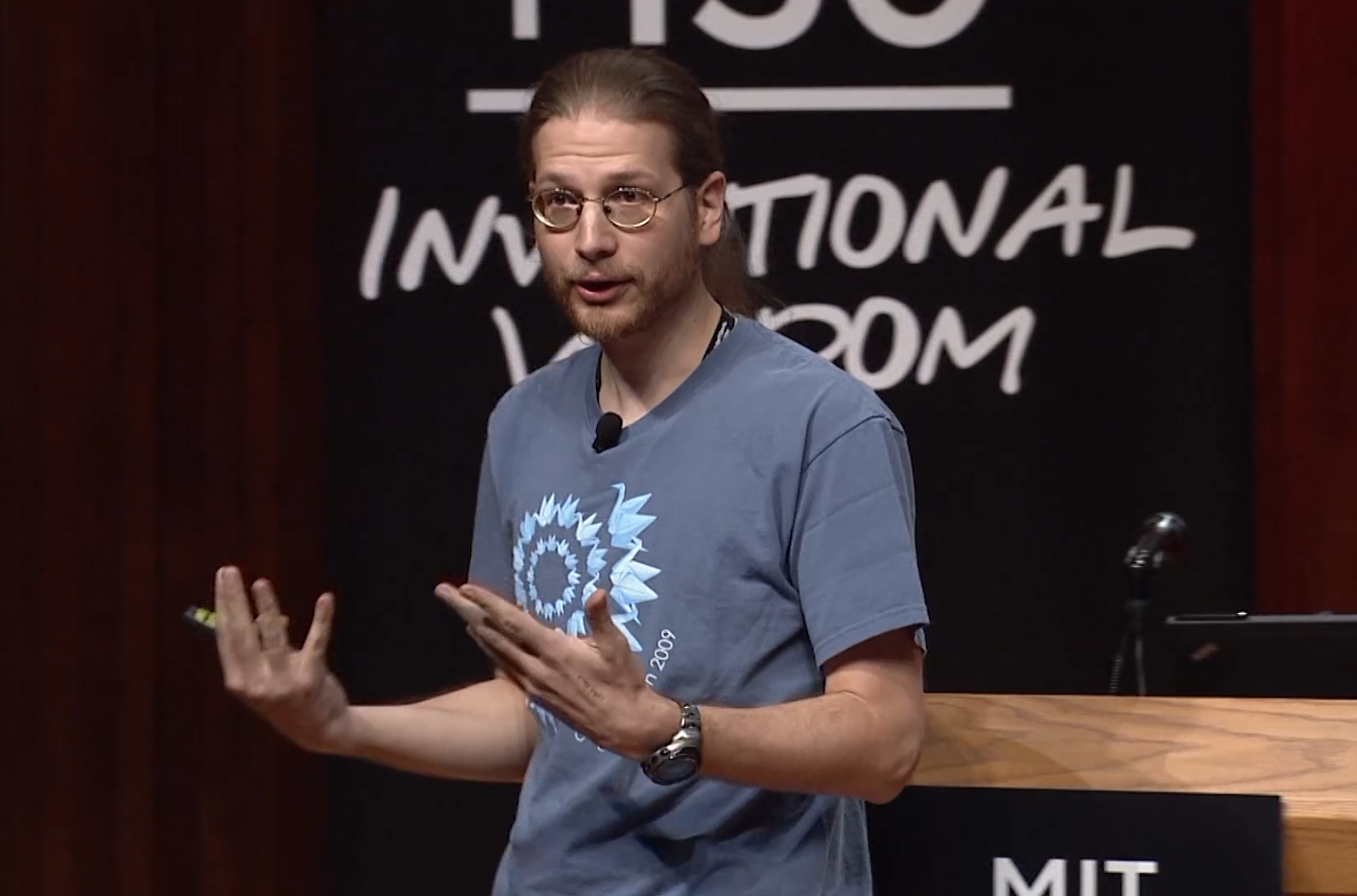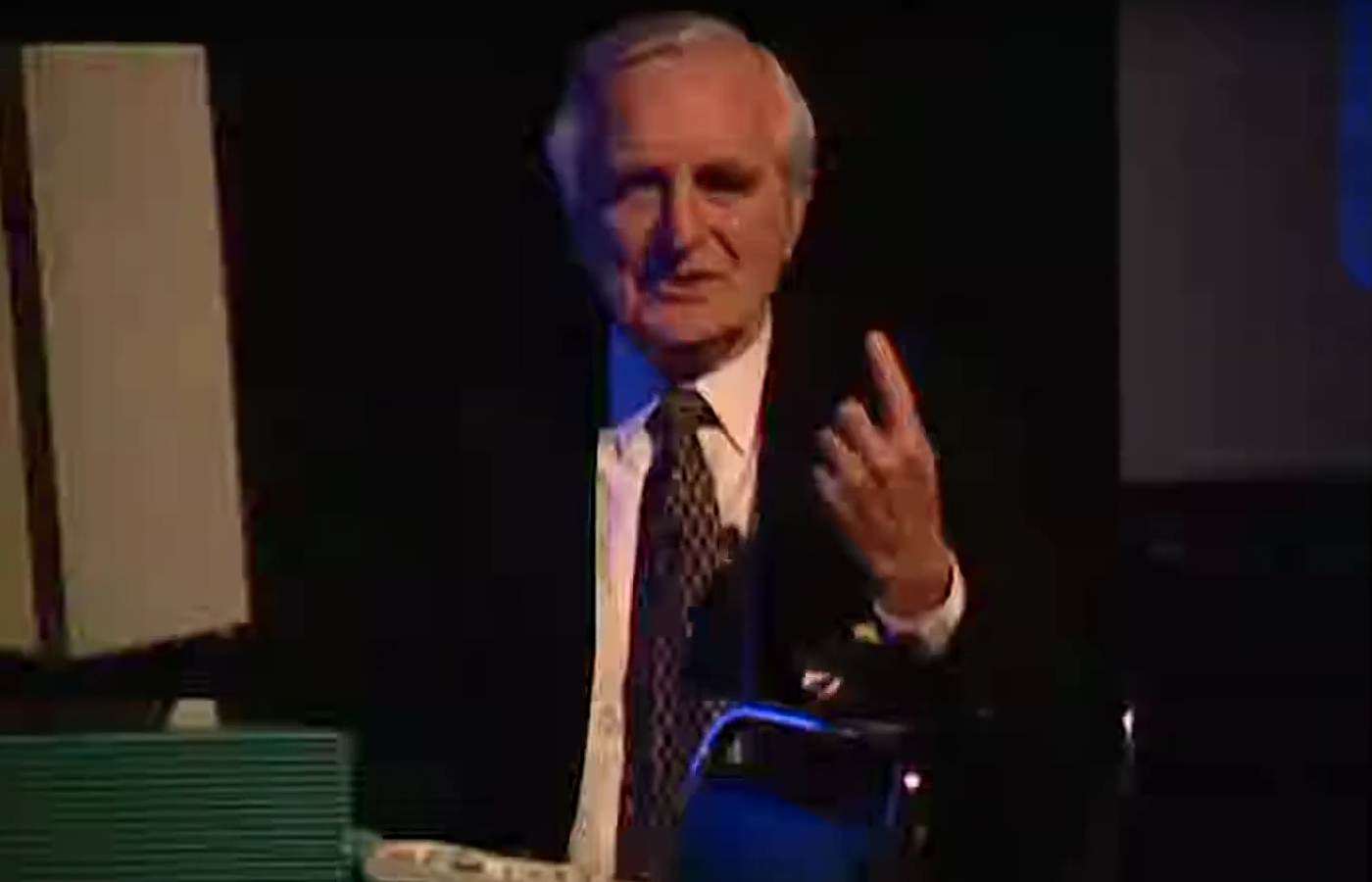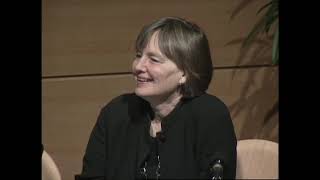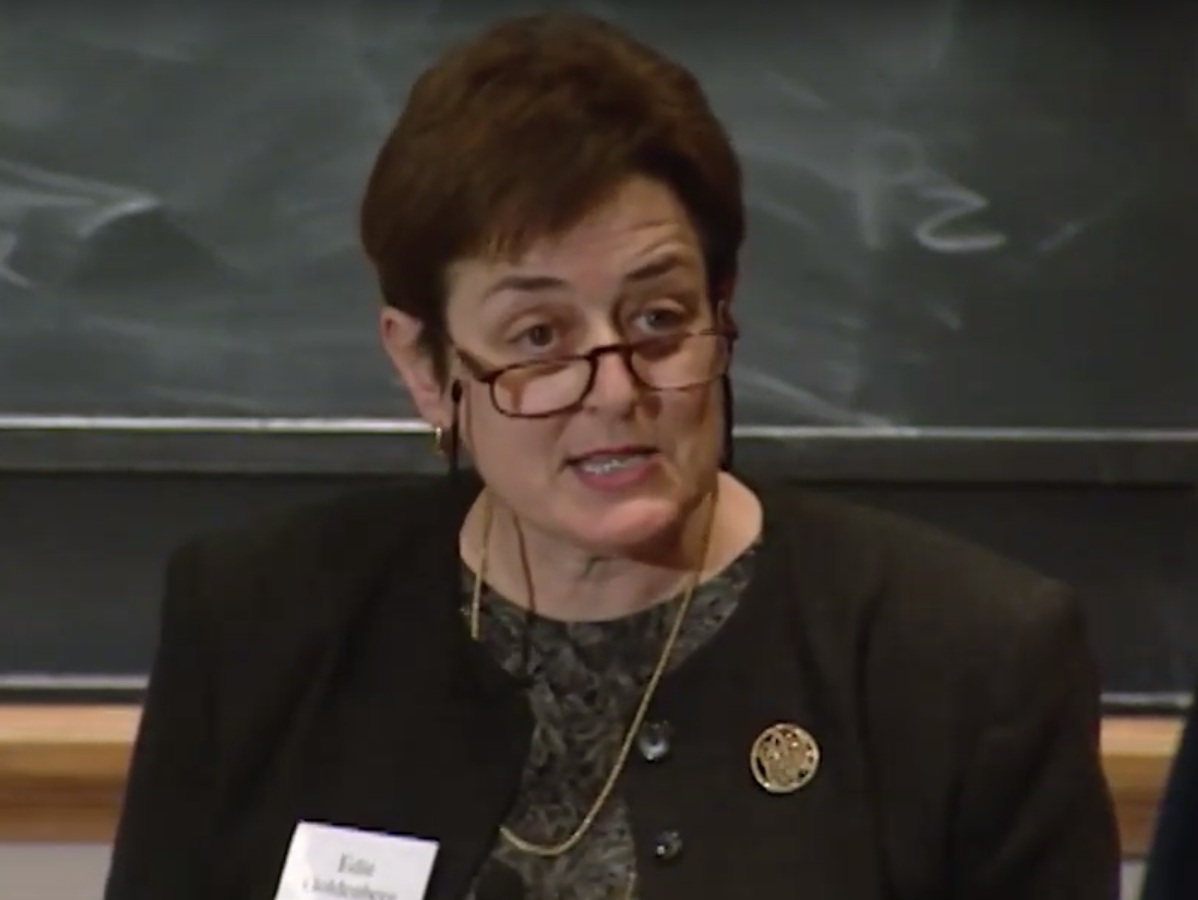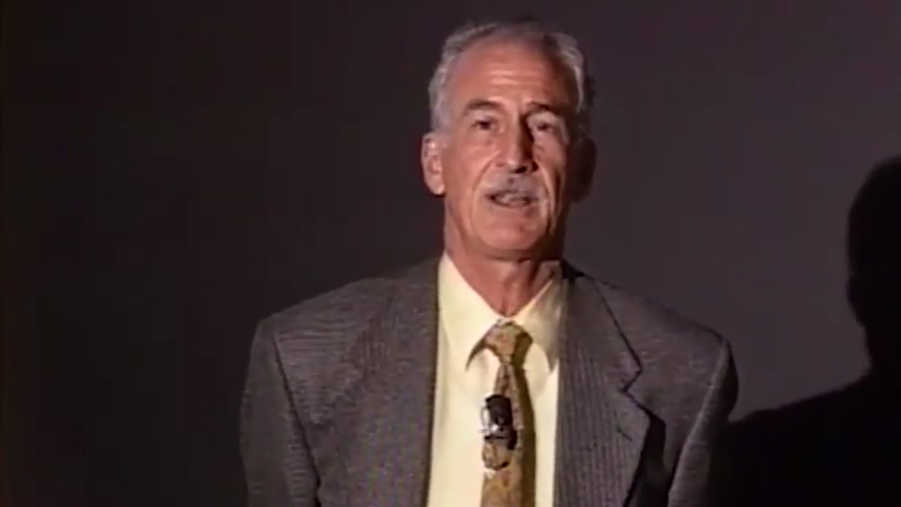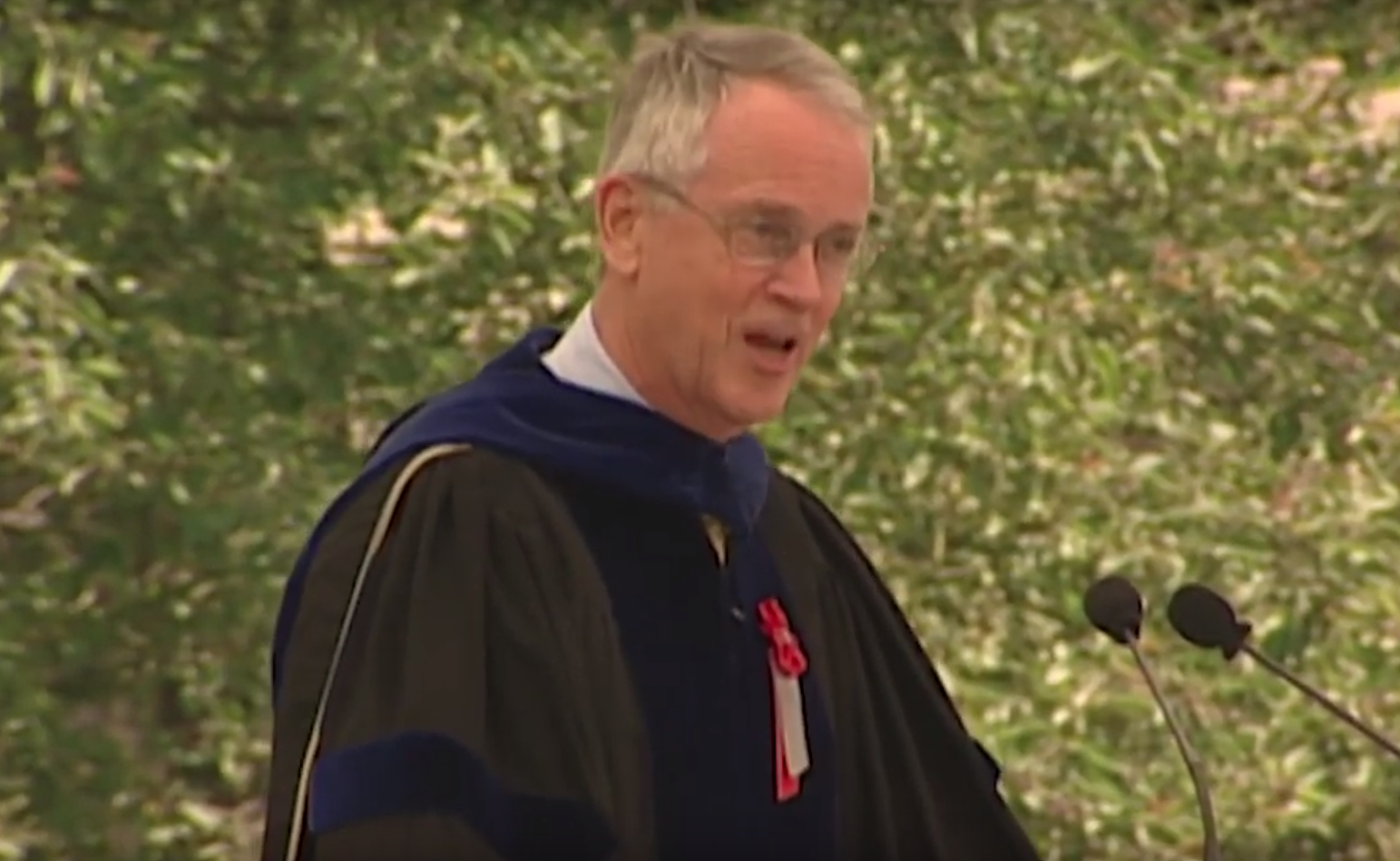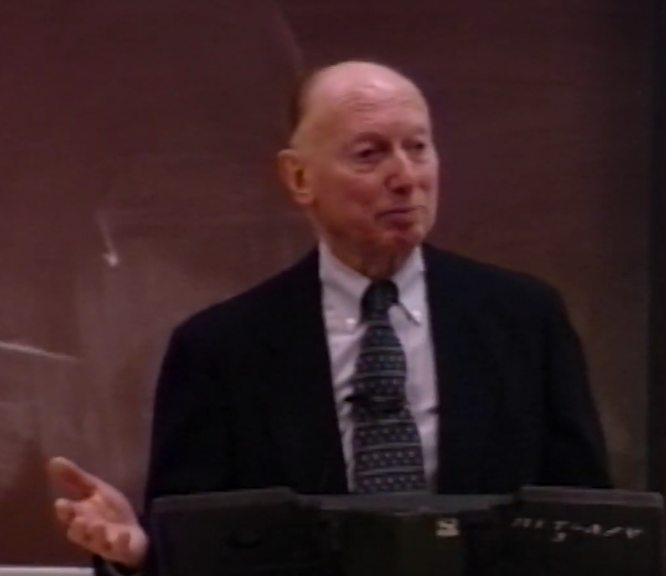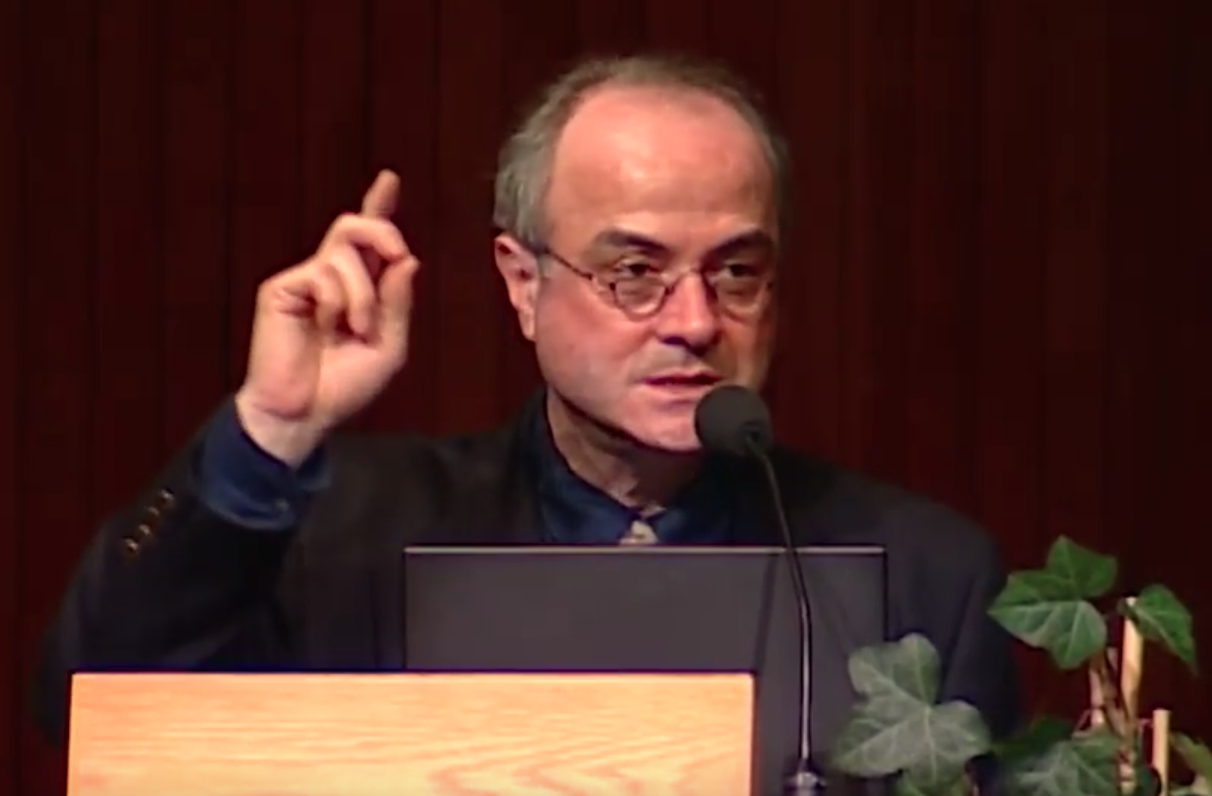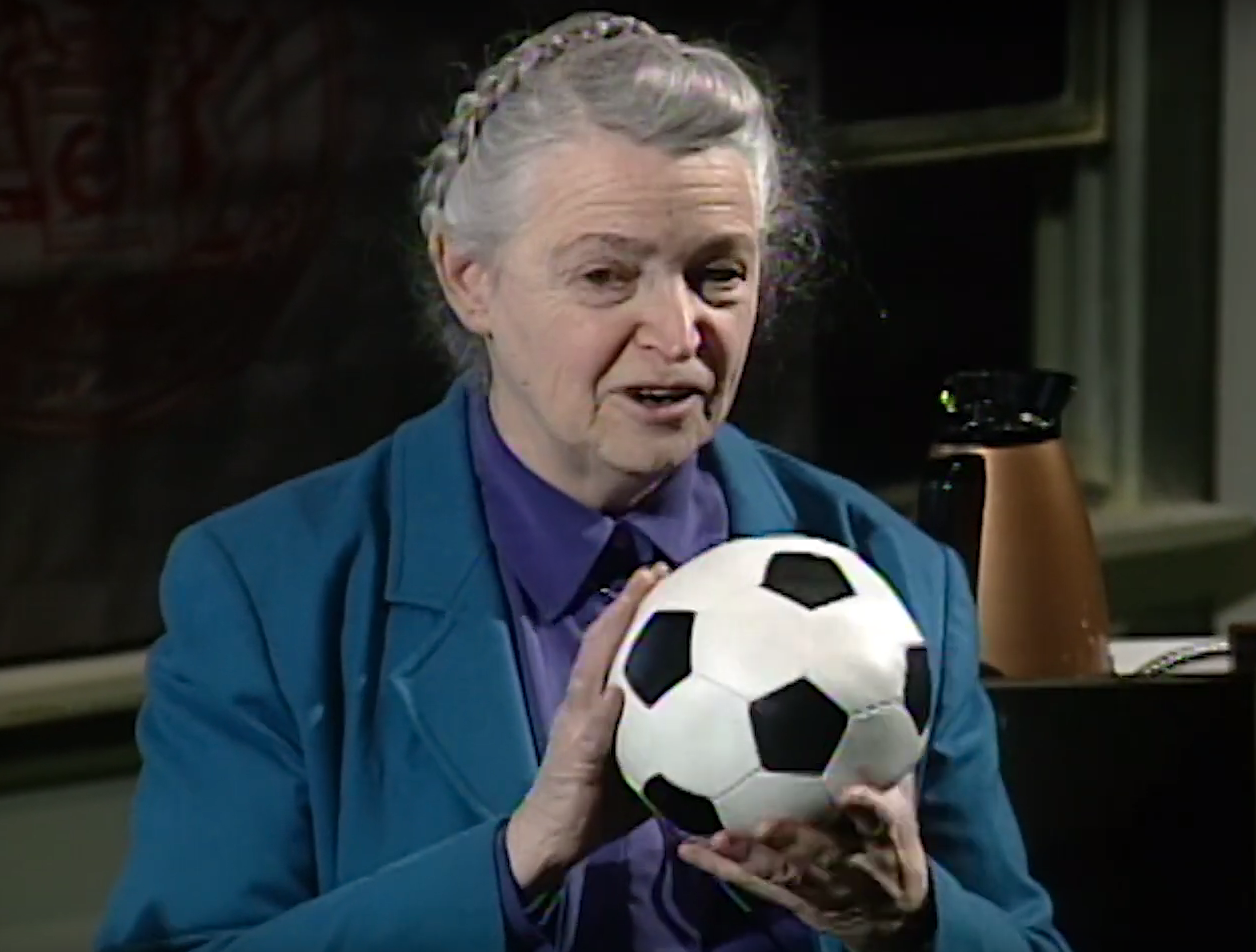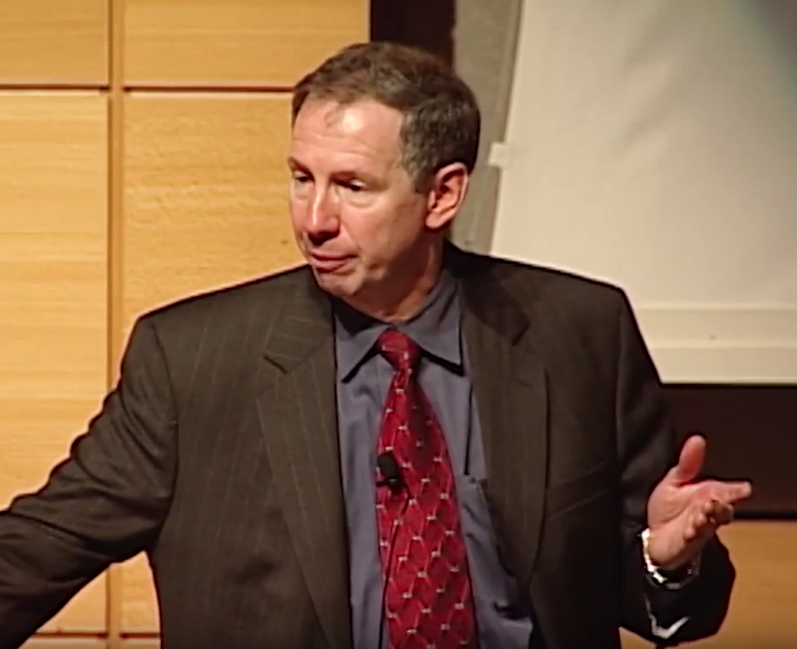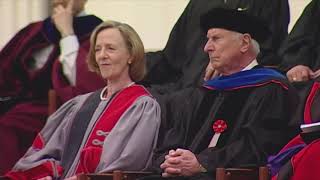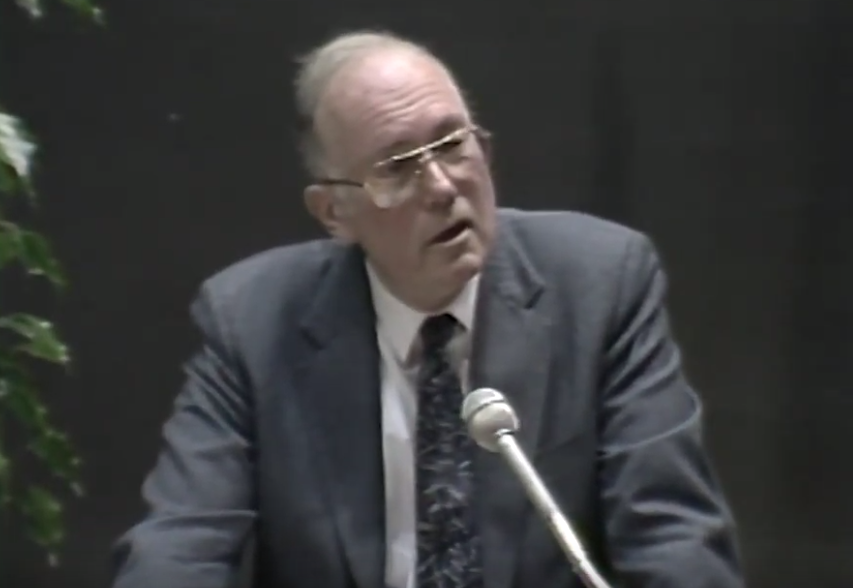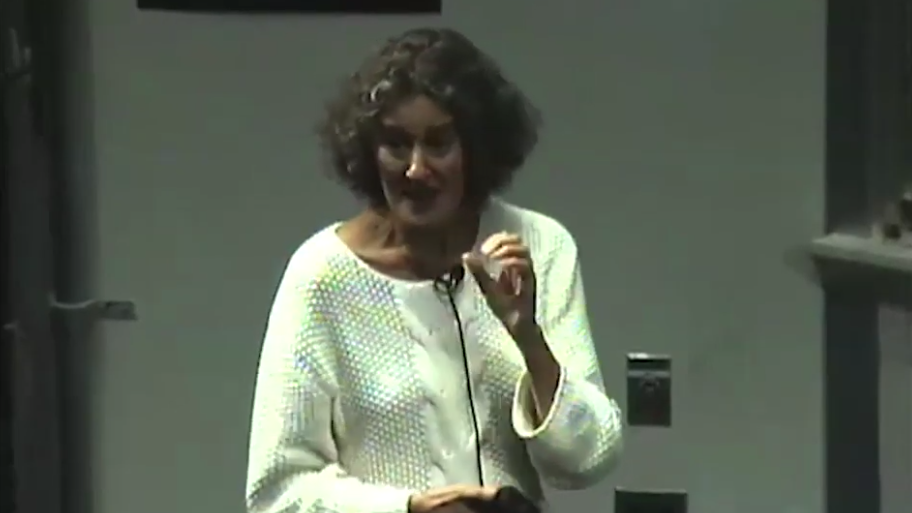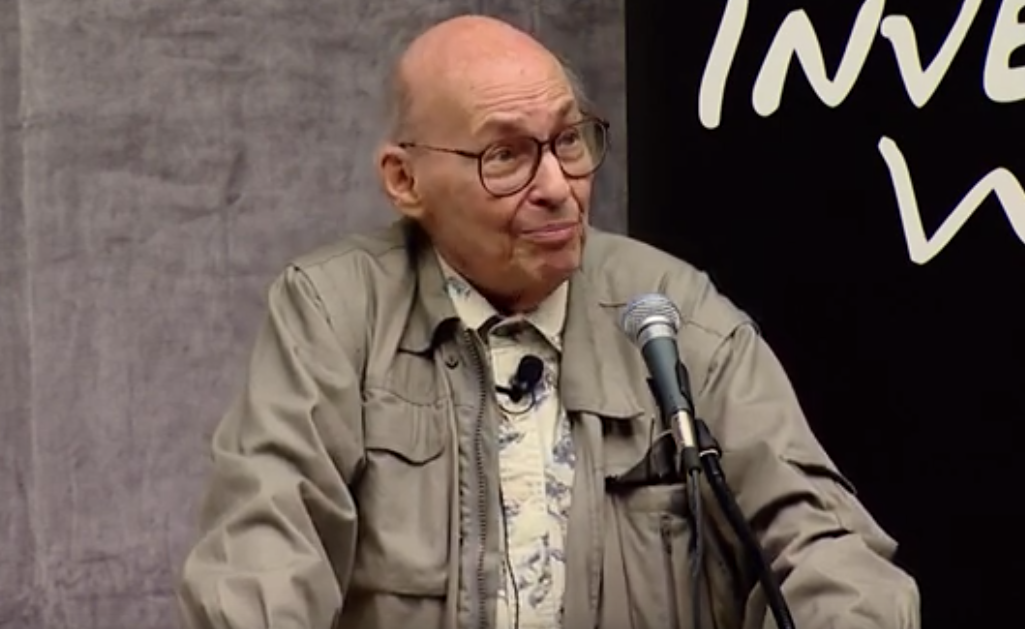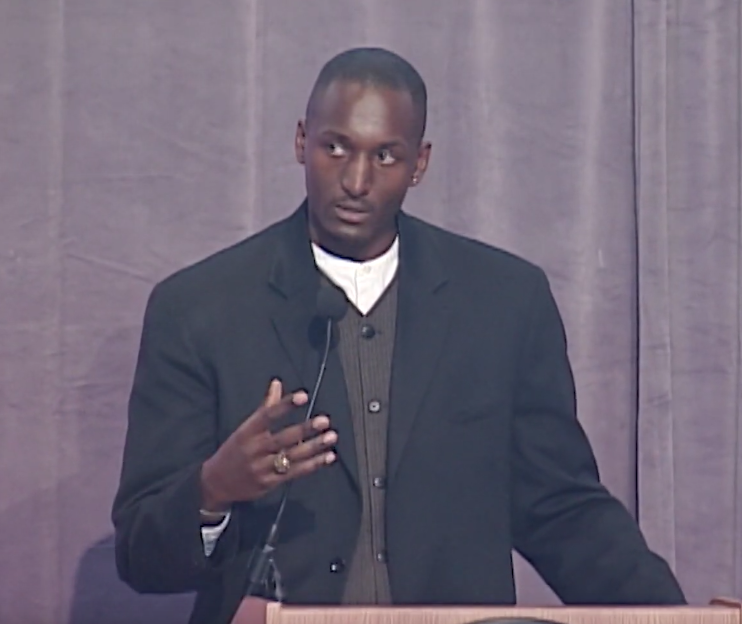Technology Day 2002—"When Worlds Collide: Science, Politics and Power in the 21st Century"
HECHT: That was just a test, and you all failed. One of my faculty colleagues reminds me that when he walks into a class, he can tell by the reaction to the words "good morning" whether he's teaching undergraduates, graduate students, or industrial people.
If he walks into the class, and there's no response except a little murmuring, he's in an undergraduate class because no one is awake yet. If he teaches an industrial class when he says "good morning," everyone, in proper corporate fashion, says "good morning" back. If he walks into a graduate class, and he says "good morning," everyone writes it down.
Welcome back to Saturday Classes. For the two or three of you in the audience who don't know me, I'm Bill Hecht. I'm your senior employee. Member of the class of '61, proud parent of a graduate alumna from '95. For the last 22 years, I've run your Alumni Association with the help of about 7,000 or 8,000 quiet, shy, retiring MIT volunteers. Those of you who are married to MIT alumni, cards of sympathy will be accepted.
My only duty in the morning is to get you here and to spend a minute or two while people mill around and get seated in order to-- ah, the freshman are getting younger and younger. And also to introduce one of my favorite people on this campus, an honorary member of the Alumni Association, Chuck Vest.
Now MIT does not give honorary degrees. But a number of years ago, many years ago, the Alumni Association was allowed to grant the privilege of honorary membership in the association to a handful of distinguished people. Of course, one of the things that's clear about MIT is the only way you get a degree-- since there are no honorary degrees-- you have to work like the very [? ned ?] to get one.
And I can remember when Chuck said goodbye to his freshman class, the students who entered when he first became president. And if I recall the remarks correctly, he said something to the effect of, well, you came here when I came here, and you're now graduating and leaving, and I still have to stay, so I guess I haven't made it yet. But we surprised him that year by making him an honorary member. And let me introduce Chuck Vest, President of MIT, honorary member of the association.
[APPLAUSE]
VEST: Thank you, Bill, and good morning, everybody. You may not know it, but I'm facing the curse of people who walk in to give speeches from podiums with paper. There's a PC sitting here, and there's no place to put your paper. So that's okay, because I sat down at breakfast and read what was on the paper, and decided it wasn't what I wanted to say anyway. So I'm going to freeform it a little bit.
I think this morning should be a really extraordinarily exciting and interesting discussion. The topic sounds a bit formidable-- science, politics, and power. But this is a particularly timely topic in my view because the way we think about those matters and indeed, even who the players are, so to speak, seem to me, have changed enormously over the last decade or so.
Larry Summers at Harvard and before him, Neil Rudenstein and I, have had a habit of getting together two or three times each term for lunch or breakfast, bouncing back and forth between MIT and Harvard. And every time I go over to Harvard, in the room we normally use in the Faculty Club, there's a lot of pictures of Harvard people.
And every time I walk in, and I look at this one little picture of President Conant, standing in his chemistry laboratory with a beaker and a test tube, mixing these two liquids together and standing in a white coat. And every time I look at it, I wonder to myself, what are the forces of history that took a person from mixing two chemicals together in that beaker to the role that he played together with the great Vannevar Bush from MIT and others in shaping the entire world of science and technology for the military during World War II?
This year, by the way, was the 50th anniversary of the beginning of the MIT Lincoln Laboratory, which I'm proud to say, today, remains the absolutely unquestioned best Defense Department laboratory in the nation and one that we still are very proud to operate. And we had an extraordinary dinner at the Gray House, the president's home here at MIT, with a lot of leaders of Lincoln Lab over the years and just about all of the living members of their advisory boards from year to year.
It was truly an astounding evening just to sit there and realize the influence that these people had had, the extraordinary commitment that they had exhibited and things that they had accomplished to keep our nation secure in the ways that we typically think about it-- radar, and sensing systems, and anti-ballistic missile technologies, and so forth and so on.
But I have to tell you, if you go out to Lincoln today, you're just as likely to find people working on biology, things that were absolutely unthought of at the time that the laboratory began or even throughout much of its history. So as we face these new kinds of challenges from terrorism, and biological warfare, and so forth, the kinds of science that are involved, the kinds of power that are involved, and perhaps to some extent, the kind of politics that are involved, are changing, in my view, very dramatically.
For a long period of time, we had a Research in Higher Education establishment in science and engineering in the United States, the envy of the entire world. And it really stood on two pillars. One was military security, which primarily funded the physical sciences and engineering. And the other was health, which of course, funded the basic research and continues to in the life sciences.
Today, those pillars are neither as strong as they once were, nor are they the only things that feed into this. The state of the economy has become a very important driver of why people in the federal government and elsewhere are willing to support advanced education, and research, and science, and technology. And we no longer can think about anything just in terms of a simple model of the federal government comes and supports things, and graduates go out to industry.
Today, we depend for the financing of MIT, for example, in almost equal measure on the federal government, on corporations who sponsor work here, on our interactions with the entrepreneurial community, and with plain philanthropy. If you look across the United States today, much of the powerful biology and life science work is, in fact, funded by wealthy individuals or foundations. So who the players are, what their roles are, I believe, are very much in flux.
And we no longer just think about military problems. We think about the environment. How is it going to be possible to keep a healthy environment for the world and simultaneously allow people to climb up the ladder of development, and strengthening of their economy, and quality of life?
We'll hear today about one of the really interesting challenges we all face, which is the application of modern biotechnology to the food we grow and eat. What's the meaning of that? What's the role of corporations as well as governments, and laws, and so forth in all of this?
Who is responsible for creating the human capital? MIT has played, in recent years, a somewhat catalytic role in helping ourselves and our colleagues to rethink a little bit. Why is it that we don't have the kinds of numbers of women in our faculties and underrepresented minorities in our faculty that we really ought to have if we're going to use the human capital of the nation well?
And of course, nothing has sparked some weird combination of politics, and emotion, and science, and just about everything else, as the topic Ron Prinn will talk about-- global change and global warming. What do we really know? Is humankind responsible for it? Is it a natural phenomenon? Are things getting better or worse? And these things have gotten mixed up-- stem cell discussions. All these things have posed for us enormously interesting and enormously important problems of this balance of science, politics, and power.
And so we hope this morning will be a very valuable opportunity for all of us to hear from four extremely knowledgeable people in four different areas which are important to these various debates and discussions. We're very pleased to have them with us. Our four outstanding speakers, we will hear from one after the other, and then there will be some open Q&A with the audience a little bit later.
We will first hear from Ron Prinn. He will be followed by Shirley Malcolm. We will then take a brief break. I got an email, said we're taking a 15 minute break at that point. I don't know if there is such a thing as a 15 minute break with 1,200 people, but we're going to try. And following that break, John Deutch and Dan Charles will speak with us. Following those remarks, as I say, we'll take some time for Q&A and dialogue back and forth among the panelists and with the audience.
At that time, and please listen, we will ask you to write your questions down on cards, which will be distributed throughout the auditorium. And we'll ask you to do that when you return from the break in the middle of the morning. There will be staff passing out program evaluation forms as well, which can be turned in to staff members after the program or dropped off in the lobby here at Kresge.
Now let me introduce our first two speakers. I will just do this all at once, and then they will simply follow each other to the stage. My colleague Ron Prinn is TEPCO Professor of Atmospheric Chemistry at MIT and is the head of our Department of Earth, Atmospheric, and Planetary Sciences. Ron's research focuses on chemistry, dynamics, and physics, the atmospheres of the Earth and of other planets.
He is particularly interested in the science and policy of climate change. He works closely with social scientists on these issues and serves as director of our Center for Global Change Science. This morning, Ron will be talking about how science and policy have interacted in this, as I said earlier, often acrimonious and complicated debate about global warming and more generally, global change. Issues such as climate change underscore the importance of scientific literacy.
Our second speaker this morning is terrifically well positioned to offer us thoughts on what and how our young people should be learning about science. Shirley Malcolm is the director of Education and Human Resources Programs at the American Association for the Advancement of Science.
An ecologist by training, at the AAAS, she oversees a broad range of programs aimed at advancing education and science, mathematics and technology, and at expanding the talent pool available for these fields. Dr. Malcolm was played an especially important role in advancing science education for groups who have traditionally been underrepresented in science-based careers.
I'm also particularly pleased to tell you two things. One, she's a really good friend of mine. She's a wonderful person. But even more important, her daughter Lindsey received her bachelor's degree in Earth, Atmospheric, and Planetary Sciences from MIT just this last year. Let me begin by asking Professor Ron Prinn to come to the stage. Ron.
[APPLAUSE]
PRINN: Yeah, I'm going to use this. Ah. Good. Well, good morning to you all. I'm delighted to see a significant crowd here. Chuck was rather kind to me in the introduction. My job is merely to warm you up to the subsequent speakers with this topic. They had to find something.
I'm going to address the issue of global warming. And I'll make the point that the science is complex. There's a lot of uncertainty, and along with that uncertainty, there's a lot of contentiousness in the policy arena. And there are some sound reasons for contention, and there are some, of course, that are not so sound.
So the first point I want to make so that you have no doubt about my position on this is that climate has changed significantly in the past, and it has definitely changed in recent decades. And I'll just show you something briefly here, a few graphs that will provide some of the evidence for this.
I don't think this is projecting as well as it should, but this is a very interesting record of climate change going back over time. And over here, we have close to 450,000 years ago. And here is the present time.
There are three curves that you see here. The middle curve is a reconstruction of temperature from the Vostok ice core in Antarctica. And then because you can also analyze the gases trapped in the ice, you can analyze what the composition of the air was back over time.
And so the upper curve here is carbon dioxide trapped in the ice structure. And the lower curve is methane. Carbon dioxide and methane are well-known greenhouse gases. They ought to contribute to warming the Earth when they have high levels and to cooling the Earth when they have low levels.
I think you can see, even without looking at the details here, that there is a remarkable correlation between the concentrations of these greenhouse gases and the temperature. That doesn't prove cause and effect, but it certainly shows that there's at least a positive feedback between levels of greenhouse gases and the response of the system in terms of temperature.
Some of these temperature changes, to just give you a calibration, from the depths of the ice age up to the present time, are well over 10 degrees centigrade. And so there have been very, very great climate changes in the past, and most of you are familiar with them as the ice ages. We are presently not quite as warm as we were 130,000 years ago in the polar regions. That period known as the Eemian is this big peak over here, and it's one of the so-called warm interglacials.
So there's very good evidence that climate has changed in the deep past. If I now focus a little bit more onto the current time, let's look at the past 140 years. And this record here, unlike the one I was just showing you, is derived from actual thermometer measurements around the world with a lot of corrections. So this is from ships and from surface observing stations.
And you see, going back to the year 1860, where the curve begins, through to the present time, the year 2001 over here, that temperatures remain sort of bouncing around. Then they increase substantially as we went into the 1900s. Then from 1940 to about 1965, temperatures were lowered a little bit. But since then, the temperatures have been increasing very substantially. So there's pretty good agreement among scientists that this is, in general, what has occurred over the past 140 years.
If you look back 1,000 years in time-- I won't go through the details of how you can reconstruct temperature, but you can use tree rings, corals, as well as ice cores to do this-- and you get this pattern. So this is the year 1000 here. Apparently, if you believe this reconstruction, there was a steady cooling. This was known here as the medieval warm period, a steady cooling to the so-called Little Ice Age.
But certainly, in the time beginning where we began to burn fossil fuels in large amounts, we see a very significant warming period. And we are up here now. The overall temperature change over the last 140 years has been of the order of 0.8 degrees centigrade. And so it has been substantial. So the world is warming.
Although I won't have time to discuss the issue of attribution, who's to blame here, recent studies, particularly in the last three or four years, make it pretty clear that human influence on climate is substantial. And the debate has switched among scientists not from whether humans are influencing climate or not, but rather how much are they influencing climate?
I won't go into that debate because I want to focus more on the future. But I give this as a prelude to impress upon you the fact that climate has changed in the past, it is changing now, and we think, certainly, for the last 100 years at least, that a lot of this change is driven by human influences.
So the science-- and I'll go over some of the issues in the science-- the science is very complex. There's no doubt that the understanding is incomplete, and we have a lot more work to do as scientists. But the question I want to ask is, what is involved in determining future climate? Can I do that just simply as a natural scientist?
I think all of you would realize immediately that if there's human influence on the climate system, the answer to my question is no. We must include knowledge of how the world will develop going into the future. How will we obtain our energy, resources that are needed? And how will we obtain the food we eat? Because both of these human activities, for example, are sources of greenhouse gases.
If we were to develop a capability to determine future climate within some probability range, can we use that to evaluate future policy effectiveness? Which is another very important issue that has to be addressed. Because, as I'll talk about, enacting policies is not a fiscally neutral thing to do. It will probably cost money. And if it's going to cost money, let's work out the way where we'll do what we need to do at the least cost.
So what would I need if I wanted to determine future climate? Obviously, I'd need to bring together knowledge of economics and technology along with natural sciences to achieve this. And for the last 11 years at MIT, we have been constructing a model that we call the MIT Integrated Global System Model.
To do this, we have formed a coalition of not just the natural scientists that are involved in understanding the climate machine, but also economists, and political scientists, and people interested in energy technology. Putting all those things together and saying, could we, in fact, construct a model that would help us think about the climate issue in a more objective way than just simply debating it with words?
So the fundamental elements of the model-- this is really a cartoon. The model runs on a very large cluster, multiple processor cluster. But one of the modules is one that looks at human activity. It is basically an economics model that does all of the usual things, resolving energy activity, agricultural activity, et cetera, within individual countries and groupings of countries.
But unusual among economic models, it projects the emissions of all of the climate-relevant gases. And there is a large list of them here. I will just name a few of them here. Carbon dioxide, methane, nitrous oxide. I've got gases here, nitric oxide and nitrogen dioxide, which you think of as air pollutants, but they influence the climate machine.
Volatile organic carbons coming, a lot of them, from the evaporation of gasoline. Sulfur dioxide and sulfuric acid coming from the burning of coal, largely. Carbon monoxide. The chlorofluorocarbons that are involved in ozone depletion are very strong greenhouse gases. Hydrofluorocarbons that, some of them, for example, used as refrigerants to replace the chlorofluorocarbons.
Perfluorocarbons, which a good example is carbon tetrafluoride produced in the aluminum industry and sulfur hexafluoride that is used as an ideal insulator in transformers and in many other applications in the distribution of electric power around the world. They're all powerful greenhouse gases or influence the chemistry of greenhouse gases.
The most time-demanding piece of the big computer model is a coupled model of atmospheric chemistry and climate processes that couples the ocean, the atmosphere, and land processes. It handles things like the big sink for carbon. One of the big sinks for carbon dioxide is the absorption of CO2 in the ocean waters and the sinking of that water to depth.
That is calculated in this model. And then that model is coupled to and drives a model down here at the bottom of ecosystems around the world. And that ecosystem model, combined with climate, drives a model of the natural emissions of gases.
I showed you data from the ice cores of the changes of methane that occurred naturally back over the past 450,000 years. Those are natural processes which you must simulate in a model of this type. Bottom line is it's a very complex model, and every one of these models has significant uncertainties associated with them.
That didn't stop us from putting it together. The good thing about being at a university and particularly being at MIT is that first, you've got to think you're pretty smart in doing something like that, and you've also got to be somewhat arrogant. And we have that mix on our team. I'm the arrogance. Everyone else is the smart part of the team.
Let me just show you some projections from this modeling effort. And I'm going to be referring to the Kyoto Protocol. I think that some of you have heard about this protocol and the fact that the United States is not signing it, but many other countries are signing it right now. More on that later.
The red line that you see up here, I'm showing polar warming in the uppermost graph, and that refers to the left axis. If we don't do any policy, the pole temperature would rise to about 4 and 1/2 degrees centigrade in this projection. If we do something with the Kyoto Protocol, and only the countries involved in that do something, you lower the temperatures of the polar regions, the warming from 1990 to 2100, only to a little bit below 4 degrees centigrade.
So you don't achieve a great deal. To achieve a great deal, you've got to go to these green lines here. They are not, obviously, very visible to you in the audience. But they then achieve a level of warming which now would seem to be comfortable. But to do that, you need an ambitious all-countries policy to achieve it.
The global warming is down in the lower set of curves here, and the same story is true here. The important thing is that the Kyoto Protocol by itself and extended into the future simply involving those rich countries does not achieve a stabilizing of the climate system, whereas a much more ambitious policy does achieve this.
Now I've put these graphs up. You can't see all of the details as though you should believe these individual forecasts. In fact, you shouldn't, because a big issue, of course, in the science itself is the great amount of uncertainty in all of these models.
Maybe some of you are economists in the audience, and you know how good economists are at predicting even maybe a month into the future. That was a good thing in forming this alliance between economic modelers and climate modelers, is us climate modelers finally met some people that were even more uncertain in their forecasts, I think, than we were in ours. Jake Jacoby will talk later in the program in the afternoon, and he will give you the opposite opinion. He's the co-director with me of this modeling effort.
What we've done recently is something that no other complex model system like this has achieved, and that is we've run 250 forecasts of this model to get a sense of uncertainty. Those 250 runs contain a lot of different assumptions within the economics, the climate model, and the ecosystem model. And for those of you who think about statistics, we used what's called Latin hypercube sampling, which is a Monte Carlo-based system, to achieve this.
And I'm going to show you some results of temperature and sea level changes. And this time, it's not going to be a single forecast, of course. It's going to be a probability distribution of the amount of warming between 1990 and 2100, and the amount of sea level rise. And then I'll also show you some probability distributions for another 250 forecasts that assume that the policy that I showed, that all-countries ambitious policy, is put forward, but adding to the fact there are all the uncertainties in projecting into the future.
So this will help us look at the climate issue in a somewhat different way. And that is what I'm going to try to do with a policy is lower the probability of extreme happenings, because that's what we're really worried about.
So here is the global mean surface temperature change from 1990 through to the year 2100. And the scale here is 0 degrees centigrade up to 7 degrees centigrade over on the right-hand side. The red curve is a probability distribution if we decided to ignore this problem through the next 100 years and just merrily went on our way. The median temperature rise, you see here, is around 2 degrees centigrade.
To give you a sense, there's a probability, according to this, if we enacted no policies, there's a probability of about 1 in 20 that we will get global warming exceeding, equaling or exceeding 4 and 1/2 degrees centigrade or 8 degrees Fahrenheit.
Now I'll point out in a couple more view graphs that the polar regions warm up a lot more than the Equatorial regions. So you'll see that this 4 and 1/2 degrees centigrade corresponds to a polar warming of about 10 degrees centigrade.
If this is the right forecast, chance in 20 is what we're saying, then we're in trouble. The tundra systems, the permafrost, the stability of the deep ocean circulation which is so important for the carbon and heat sink in the ocean, these systems along with the great glaciers that sit in Greenland and Antarctica, you have to be seriously worried about their stability. So this is worrisome, at least in my mind, a chance in 20 that the only planet we have to live on may warm more than 4 and 1/2 degrees centigrade or more.
Now the policy I talked about which was an ambitious one, you see, lowers the median, well, a little bit, down to about 1 degree centigrade. But the big thing that it does is it lowers the probability of the extremes that I was just talking about. Almost negligible probability of getting more than 4 and 1/2 degrees centigrade or more. So we think a better way to talk about the climate issue is to say we want to enact policies, we understand it's uncertain. So let's lower the probability of extreme events.
Let's look at sea level rise, very quickly, that accompanies these two. Here's the no policy. The sea level rise around 40 centimeters or so median. But you see significant probability for 70, 80 centimeters over here. Again, that's a lot of sea level rise, and a lot of low-lying areas around the world would be in jeopardy. Again, the policy, by enacting it, lowers the probability of these extremes in sea level rise.
Because the science is uncertain, of course, we can't say anything more than lowering odds. But again, I impress upon you the usefulness of doing that. Here's the median no policy and policy curves. And this emphasizes the point I made earlier that the polar regions in all climate models, credible ones, warm up a lot faster than the Equatorial regions. So certainly, the most vulnerable systems are likely to be those in the polar regions.
And regrettably, as you see in the median forecast, even in the median forecast, 4 and 1/2 degrees centigrade or so warming in the polar regions is the median in these projections. Bottom line, we all ought to be concerned about this problem. So if we're concerned about it, and we want to enact policies, what will it cost to lower greenhouse gas emissions?
The Kyoto Protocol is, I think, well known to many of you. Very quickly, it involves the rich countries of the world. Globally, we want to lower the greenhouse gas emissions by these rich countries, known as the Annex B, to be 5% below 1990 levels by the year 2010, with that range around it.
There are different national targets. The US is supposed to lower by 7%. The European Union, 8%. But Australia can expand by 8%. I won't tell you the politics that went into Australia doing that. I'm not an Australian, by the way. Emissions trading, that enables you to trade with other nations, the reductions, so that you can meet your target at lower cost.
Hot air is the Russians. The Russians are part of the Annex B. And curiously, their current levels of greenhouse gas emissions are lower than their 1990 levels because their economy is in deep trouble. And so they can sell the so-called hot air to other countries because they're already below their target.
You're allowed to have carbon sinks included with limitations, that means forests. If you can sequester carbon in various ways, then you can use that. You can work with other countries, non-Annex B countries, developing countries, and get some credit for activities that you do in those countries to lower emissions.
And it involves the use of global warming potentials because you've got to relate the greenhouse gases to one another and say, well, does 1 ton of carbon dioxide reduction equal 1 ton of methane? No. It's 20 tons of carbon dioxide equals 1 ton of methane, because methane is a stronger greenhouse gas. Won't go into the details of that.
What are the costs of the Kyoto Protocol? You're not going to be able to resolve all of this, but anything that's hanging downwards is a loss of consumption. And the scale here is 0 down to 4% here in the upper set of curves. And anything above the 0 here is a gain in consumption. And you can think of this as either a positive or negative aspect of costs for the various countries.
The set of curves at the top is rather interesting. It is the non-Annex B countries. And you see that some of them, for example, this set of curves here, that they, in fact, lose substantially. And the ones that lose substantially are the energy exporting developing countries, particularly those in the Gulf Region. Why?
Simply put, the value of oil goes down because of the policy, because of the restrictions, and the value of their imports, particularly of energy intensive goods, goes up. And so they lose on both fronts. And so some of the biggest cost will be, in fact, borne by non-Annex B countries, the big oil and gas exporting countries.
Down here are the Annex B countries. You can't see all of the curves. But for the United States, it's going to be of the order of maybe 1/2% to 1% type of effect on total consumption, which you can think of as some measure of the costs. There are two sets of bars that you see here. One set of bars, that's the purple ones, generally shows lesser costs than the one that is beside it. That just is determined by whether you trade emissions among countries.
Put it in a simple way, a country like Japan that already has very great energy efficiency, if it can get credit for building power plants in China that are highly efficient, and it's cheaper for Japan to invest in that way than in their own utility system, then it saves them money, and they achieve their target.
That's known as trading. It benefits almost all of the countries. It particularly benefits Russia, because I mentioned before, it has this hot air to trade. And you see that they are doing wonderfully. This big bar here is Russia, trading with the rest of the world.
This all assumes that everyone signs the Kyoto Protocol. Now we know that that's not happening. We know that the White House, last year, put forward what I've called here the Bush Protocol. Sorry, just at the beginning of this year, the Bush Protocol. The idea here was to look at intensity, which is tons of greenhouse gases per million dollars of GDP. It was voluntary. It suggested more research funding. I certainly love that suggestion.
There are a lot of domestic initiatives, tax incentives, transportation efficiency, sequestration, that's another name for bearing carbon in one place or another, international initiatives, assist developing countries, bilateral agreements. And most recently, just in the last week, adaptation to inevitable climate change. This got a lot of discussion in the news over the past week. And perhaps in discussion time, some questions will come up about that.
What is the bottom line in the Bush Protocol? The US is already 12% above its 1990 emissions right now around the present time. And if the US economy grows the same in the next 10 years it did in the past 10 years, then the bottom line is that this protocol will lead to an additional 8% increase in greenhouse gas emissions. So we'll be 20% above 1990 levels. Our target was minus 7%. So we're 27% below Kyoto targets. So this is nowhere anything like the Kyoto Protocol for the United States.
So where do we go from here? Will we have a continued impasse? Will the Kyoto and the Bush proposals be harmonized some way? Will the Kyoto Protocol be softened? Will the Bush Protocol be hardened? It could be hardened by making its goal of lowering emissions intensity by 18% to be significantly more than 18%. We don't have an answer to that question.
I've emphasized the fact that this is a long-term global problem. And we're going to be looking at sequential decisions under uncertainty. We're not going to decide now what to do, and then follow blindly that policy going into the future. So that says, let's move forward and make those first steps now even if they're relatively modest. As you all know, we have yet to make those relatively modest first steps.
We should be putting all of the technology options on the table, considering every one of them-- nuclear, renewables, the use of coal but extracting the hydrogen out of it only and sequestering the carbon. Many, many possibilities exist. They all have got to be put on the table to help us here.
We're going to have to prepare for inevitable climate change. I didn't mention the fact that because the ocean takes up heat, it's delaying the ultimate warming. And we're getting fooled as to the size of the ultimate warming for a given level of greenhouse gases because the ocean is slowing down the warming. But once the ocean warms up, we will see a much higher temperature change than the ones in the graphs that I showed you. So adaptation is going to have to be part of our thinking.
And finally, I say, will nature help? It would be nice if nature gave us some mild surprises right now. Think of the ozone depletion problem where the Antarctic ozone hole conveniently appeared in 1984, was discovered, and it really was an impetus to drive us towards policy because the Antarctic ozone hole wasn't even in the models. The problem was worse than the models were showing. Of course, we don't want nature to punish us with having too big a surprise.
So my final slide suggests one way in which if nature is kind to us, it could do something. This is a picture of big icebergs breaking off the Ross and Ronne ice shelves in Antarctica. This is just one of those events. This is 11 September, 2000, 4 November, 2001, and 12 November, 2001. So six days later, you see, here it is. Here's a big iceberg breaking off.
It's the size of the island of Dominica. What we need is something maybe 10 times the size of the island of Dominica maybe to get people's attention, and to say maybe things are going on that we should be driven a lot quicker and with a lot more careful thought into having a global policy to address this issue. Thank you.
[APPLAUSE]
MALCOLM: Good morning.
AUDIENCE: Good morning.
MALCOLM: Am I on?
AUDIENCE: Yes.
MALCOLM: I'm on. Okay. I'm pleased to be here for Technology Day. This is my first Technology Day. And maybe I should begin by answering the question, at least the first part of this question, that way, you won't have to wait for the punchline.
Perhaps Ronald Prinn answered the question, what does the next generation-- what do they really need to know? One of the answers is they're going to have to know how to deal with complexity and uncertainty, and accelerating advance of knowledge. And I guess that's where we come in. And then how, in fact, can we get them there?
What young people have to know has really changed over time. It used to be the case that people were considered literate if they could write their name and read from the Bible. My grandmother, who was born in 1886, finished the 8th grade, and she was considered literate. She was a very wise woman. She had a lot of practical knowledge, large part of knowledge of nature. And she could cipher. She was very good at ciphering, so she had an understanding about how to manipulate numbers and ideas.
We have changed our mind from time to time about who needs what kind of education. There were very few people who were thought of as needing academic knowledge or book knowledge, but a lot more people who were thought of as needing technical or vocational knowledge, or craft knowledge.
It is interesting that we have changed our minds over time about how much of all of this we actually need. I took algebra when I was in the 10th grade in high school. On the other hand, my kids took algebra when they were in the 7th grade. Now I don't think they were that much smarter than I was. Or maybe they were-- we do have at MIT grad among them. But I think the major issue is that we have changed our mind over time about how much young people have to know and what they're going to be able to do.
We've also changed our mind about who does what. When I was in elementary school, I took sewing and boys took shop. When my children were in middle school around the same grades, boys and girls took sewing and shop.
Now let me just begin by saying that I am part of the post-Sputnik baby boom generation. I am one of the 50-somethings that emerged from that whole effort and from the needs of our country for more scientists and engineers. Science was emphasized a lot more. We had a lot more things that were going on.
So it isn't just a matter of having our beliefs from society affecting what we think students need to know and be able to do, it is also these external issues, such as the Soviet launch of a satellite into space.
We identified the need for more scientists and engineers. We invested in teacher institutes in science, mathematics, and foreign languages. We provided support for laboratories and other infrastructures within our high schools. And we undertook a massive effort of curriculum reform in science and mathematics.
And then President Kennedy upped the ante. Our goals had been fairly modest at first, basically, catch up. But it seemed like we were never really catching up. They launched a satellite, we'd launch a satellite. They'd send an animal into space, we'd send an animal into space. They send a man, we send a man.
But we were always behind. And all of a sudden, we had this larger goal that ran ahead of what was already on the table. So then the question is, how did we accomplish that? How do we land a man on the moon and return him safely to Earth? And in that case, they actually meant a man.
The issue was how to make it happen. And I think that these things are a large part of what it took in order to make it happen. A strong industrial and university base-- the ideas had to come from someplace. Targeted infrastructure-- we really did have to create an agency and assign responsibility to somebody to actually make this happen.
Funding that was commensurate to the task. And one of the things, if you actually look at the funding for research and development over the past 50 years, one of the things that you will notice is that our priorities in funding have changed over time. And when we decided that we were going to take on this goal of landing a man on the moon, we poured a whole lot of money into space science and into the effort to actually get them there.
Putting the best people on the job. We had some dedicated, hardworking, and very smart people that were identified to undertake this task. And we had brought political and public support for the effort, and for however much money that needed to be spent, and for however many lives were lost in the interim. People understood what the goals were.
Now the question is, what were the results? As I said, many of us are the results of this-- the 50-something scientists and engineers who were a product of the post-Sputnik push. There was a lot more attention to science and technology. There was a lot more science being taught. There was a reinvigoration of the teaching corps, the development of new curriculum.
And there were lots of technological spin offs. The whole process of trying to accomplish this meant that we had to discover a lot of things, how to miniaturize things, how to protect things from extremes in temperature. And so it, in fact, fueled a whole technological revolution.
So we landed the man on the moon. And then we landed more men on the moon. And we went that way for a while. And then all of a sudden, we woke up in the early 1980s and declared that we were a nation at risk.
So the question is, what happened? One of the things that I think we've come to realize is that problems that get fixed don't stay fixed. Things happen. The world moves ahead. If we look at this point in time, what led up to that point in time, there were lots of other things besides concerns about science education that were on people's minds.
The '60s and '70s were a period of unrest and of social movement that had to take place, be they civil rights, or women's rights, or Vietnam, or whatever it is, Watergate. There were lots of other things that were going on. So you could lose attention to the whole question about what was the quality of education and what it is that ought to be taught.
There were lots of things that were going on about arguments about the federal role in education. One of the first things that happened in the Reagan administration was the closing of the shop of science education at the National Science Foundation. And so that sends a real signal about the emphasis that is being put on education. Because the belief was that education was a local issue, and that it needed to be dealt with locally, and that it was not this question of a federal role.
But there were new threats. There were new threats in terms of a buildup of arms, in terms of economic weaknesses that were beginning to appear, in terms of environmental concerns. It was already clear that the economy was shifting to one that was knowledge-based.
And so one of the things that happened was when the National Commission on Excellence in Education began its work, it essentially declared that if someone else had visited on us what we had done to ourselves, that we would consider it an act of war. By that in fact, our loss of attention and our loss of resolve had put us someplace that put our nation at risk.
So then the question is, what is the response to that? Interestingly, one of the major responses to the Nation at Risk report was to increase the amount of science and mathematics course taking. But in order to do that, every state had to essentially declare that students had to take more math and more science, or they had to take courses that had something to do with technology, more that had to do with computer literacy.
And so if you look over time, what you see is, in essence, a real buildup in the percentage of students who ended up taking the courses in mathematics and science. In 1982, less than 50% of our students took-- high school students-- took geometry. By 1998, it was over 75%. Now I think that that is an amazing increase in terms of a focus on science and mathematics for that time. And you can begin to look at some of the other trends as well in terms of mathematics and science course taking.
And of course, one of the things that that does is that when more and more students take the fundamental courses in mathematics and science, more of them are able to choose college majors and college courses that involve science and mathematics as well. So we saw a tremendous buildup in the numbers of degrees that were being awarded.
Now of course, part of this is the change in the numbers of students who were going to college. Some of it from the post-- what is it? The baby boom echo. But a lot of it had to do with the fact that a lot more students could, in fact, undertake these majors and that there were increasing economic opportunities that were presenting themselves for being able to take courses in these fields.
One of the things that I think that you will notice is that one of the largest social trends that are present in these numbers is actually the increase in the percentage of women who have been getting degrees in these fields. If you would look at the year 2000, which I put down there because the rest of them are expressed in decades, but if you just look at the 2000 numbers where women received over 50% of the science and engineering degrees, bachelor's degrees, 43% of the master's degrees, and 36% of the PhD degrees in science and engineering.
In 1989, President Bush, Sr., and Governor Clinton joined together at the Charlottesville Education Summit. This convening of the nation's governors and the President was unprecedented. What they wanted to talk about at that time were fundamental goals for education that everyone, in fact, needed to embrace.
The education goals were fairly straightforward. That all students enter school ready to learn, by the year 2000, that is. To increase the school completion within the United States. To increase student achievement and citizenship. Let me just say that Goal 4, at that time, that came out of the Charlottesville Summit was that by the year 2000, that the United States would be first in the world in mathematics and science achievement when compared with the other nations of the world.
When Congress considered the goals, they wanted to add goals. And so then Goal 4 became Goal 5. They added goals that related to teacher education and professional development. And they added goals that related to parental participation in young people's education.
Now let me say that in order to make sure that this happened-- remember, this was 1989, and they were looking out toward the year 2000. In order to make sure that this happened, they called for the establishment of a National Education Goals Panel that would monitor progress toward these goals and also support the work that was being done.
This was to be a bipartisan group that had representatives that were appointed by the executive and the legislative branches, that would have local people, and that would, in general, have a mechanism or produce a mechanism for giving the nation's report card.
Now the interesting thing about this was to ask, why was this necessary if, in fact, you had this increased course taking within the states? There is course taking, and there is course taking. It is an imprecise way of gauging whether students have learned something. And as a matter of fact, the question of, what is this algebra course, and how does it relate to that algebra course, was something that we really never had a way of grappling with.
And so there was the proposal that we began to develop standards, statements of what students needed to know, should know, and be able to do. These were done in many different fields, not just in mathematics and science. They were done in geography, history, the arts, English, language arts, and economics, and other groups. There were all of these groups, largely from the profession, that were working independently to develop these standards.
So the question that I actually chaired a group to consider while looking across all of these standards-- how would you know that they were worth adopting? And so I had this assignment to begin to develop something called standards for standards. And I know that sounds a little bizarre, but in fact, these are the criteria that we came up with. That they be world class. That they be important in focus, useful, reflective of broad consensus building, and so on.
The first group that was really out of the gate on this was the National Council of Teachers of Mathematics. The mathematics community-- and it wasn't just the teaching community, it involved the mathematicians, the statisticians, as well as the college mathematics educators. They came together, and did this work without federal support and before there was even a standards movement. In some ways, the mathematicians were the first ones to address this.
But apparently, they perceived this as being so controversial an idea that they began quietly, and no one was really working. They got themselves underway very early and started to reflect on how they were going to achieve this and what it ought to say.
Because it looked very different from what we're used to seeing. That is that you take algebra, or geometry, or pre-calculus, or whatever the course might happen to be. It required a total resetting of the standards, the concepts that were considered important and enduring.
My organization, AAAS, began to look at this within the sciences quite early. This is called AAAS Project 2061 because this work began the year of Halley's Comet. Some people said that they thought the work would probably finish when Halley's Comet came back, but that's not the origin of the name.
The idea is that, in fact, we wanted to articulate goals for the next generation, not for this generation, for students, for young people who were going to be around when Halley's Comet came back, what were they going to need to know and be able to do?
The first book that was produced was Science for All Americans. It has been translated into many other languages. And so it is now really considered science for all in its Spanish, Chinese, and other versions. And then an unpacking of these statements in something called Benchmarks for Science Literacy, which is an expression of the individual kinds of goals by level, the study of which would be necessary in order to achieve an understanding of these fundamental concepts.
The National Science Education Standards from the National Academy sought to build a consensus on science education. And it supported an inquiry-based education strategy in terms of teaching this science. The idea was that we had to prepare students for a world that was based in science and technology, not the world of our parents, and not the world of our grandparents, but the world of their future.
New tools were available for learning. And these new tools were beginning to affect the nature of all work. There were changing practices. The focus on quality. And this meant that the knowledge and skills had to be embedded deeply within the workforce. The knowledge of science and knowledge of statistics.
I remember visiting a new Volvo plant, then new in 1985, in Gottberg, where they were moving, they were transitioning from an assembly line to teams that were building whole cars. And the kinds of skills that they needed and the kinds of people that they were hiring were very different.
One of the most fundamental changes of all was to move from a notion that science and mathematics were things to be taught to an elite to the notion that science and mathematics was, in fact, needed by all. How do you, in fact, accomplish something that we have never been able to do? How do we provide the kind of education for the many that has been previously reserved for the few?
There were major demographic shifts that were going on. Increased numbers among groups for whom we have traditionally provided a poor education, and where there has been little history and tradition of participation in science and engineering. Women, underrepresented minorities.
So the goals of science education fundamentally shifted, not just to employment, but of course, to employment, and not just for scientists and engineers, but for those for whom they were encountering science and encountering mathematics in very different kinds of ways, reflecting the changing nature of all work.
The changing political choices that were going to be confronting young people, environmental choices, the recombinant DNA discussions that took place right here in Cambridge, biotech, global climate change-- these were very different kinds of ideas that young people were going to have to be addressing.
Personal decision making for ourselves and for our families, and given the pace of change in the acceleration of the knowledge in science, mathematics, and technology, the likelihood that science, and mathematics, and technology would become even more important in the lives of young people in the future than they had, in fact, been in the past.
So how do you find the balance? What should everyone know? What do you need to teach people who will become scientists and engineers? How do we, in fact, make some kind of a compromise between depth of knowledge and breadth of knowledge? Between being definite on the one hand, and being flexible and adaptable to the local situations in which this knowledge was going to be encountered.
Between theory and principal on the one hand, and facts and information on the other. Between formal knowledge and applications. Between teaching students about the past, the traditional knowledge, and looking forward into the future and the knowledge as they would meet it.
The discussion has basically shifted to one of knowledge working for young people, moving away from discussions of algebra or geometry to those of quantitative literacy. How do you make mathematics useful to the work that you will encounter? How do you connect across the sciences as well as connect across the years?
Now in this kind of environment, the stove pipes will not work. Chemistry here, physics there, biology over here, earth sciences over there. This is not going to work. And yet, this is the way young people are still encountering the sciences in their schools. The problems and issues that the next generation will face will not fit neatly into our core structure.
Now this is a page from one of the books, the Atlas of Science Literacy, that was produced by AAAS. And this is the atlas, this is the map of concepts that are related to variation in inherited characteristics. And I just want to show you how, because knowledge builds one year upon the next, how important it is that we all agree on what it is that we need to know.
Across the years. A K-2, a kindergarten to 2nd grade concept, around the issue of variation in inherited characteristics, this one can be summarized as same and different. That is that while you can be very much alike, you are, at the same time, different. And somehow, this evolves through that map to being able to understand the issues of not just kinship, but of the relatedness of human beings to each other and to other species.
As an adult, you may meet this issue from a very different standpoint. This is a book that we developed as a component of the support for the legal, ethical, and social issues related to the Human Genome Project.
Because the adults aren't going to be able to go back to school and start over-- it's same and different-- and move themselves up through so that they can come to understand complex scientific ideas that emerge from the Human Genome Project or the issues that they are likely to face as we try to grapple with this. And so we have to begin to see how, in fact, we can help adults come to this understanding and development resources that are appropriate for them.
It isn't just about school work and about book learning. There have to be experiences that are provided that let young people see science and engineering at work. The interesting thing is that engineering is, in fact, not even taught in K-12 education. And yet, a large part of the decision making that young people will need to confront is around the whole question of design within constraint and the uses of technology in their lives.
Interestingly, a lot of the work in pre-engineering, if you would call it that, has been provided as a part of out-of-school experiences. For those groups such as women and minorities then who have had very weak traditions, but as a way of beginning to introduce these ideas from engineering as well as engineers themselves to young people. But there is the need for them to encounter the engineering and the technology in real settings.
So the question is, how do we do this? There is too much to be known. And it's only going to get worse. So how do we develop just-in-time access to knowledge? And one of the ways is, of course, that we have this thing out there called the internet, where there is the possibility of young people being able to get access to knowledge just in time, when they need it, building from a solid foundation of formal education.
But the difficulty is that there's lots of great stuff on the web, but there's also a lot of junk on the web. So the notion is that one of the things that we have to make sure that we provide young people are the tools for discernment. And the premium is going to be placed on having those tools.
One of the good things about the technology is that it is attractive to the intended audience. This is a figure that shows the use of the internet by age. And if you will see here that we have high usage in the very age groups that we're really talking about needing to attract and needing to reach.
The thing that is really clear is that we must prepare young people to continue to learn. We have to prepare them to learn for a lifetime. But we have to give them the foundations that are adequate so that they can, in fact, continue to learn for a lifetime. Now how do we do that? And this is really the slide that I want to leave you with.
When we decided that we wanted to put a man on the moon and return him safely to Earth, this is what we did. We had a strong intellectual base, and targeted infrastructure, and funding that was commensurate to the task. And I say that in order to achieve the kinds of changes in education that we're going to need to in order to have one that provides students with the base that they need for the lives that they will live, then we're going to have to move beyond problem identification to problem solving.
And this means that we are going to have to provide a strong intellectual base, much of which is really within the scientific, engineering, and technical communities. That is it takes capacity to build capacity. And we have to use the colleges, universities, industries, and national labs in order to help to move this particular issue.
That our current highly distributed system of uneven quality is unlikely to get us there. And yet, we have real problems, as a country, talking about a Ministry of Education or some equivalent that, in fact, will help us to focus our ideas and our efforts.
Funding that is commensurate to the task. We know that this is not an issue in education. We have not had the investment that is really needed. We have labs that were not invested in since Sputnik. And so, in fact, we have decaying infrastructure. And therefore, not the quality of education that we perceive all young people as needing.
How do you get strong people into teaching? How do you support and raise the skills of those who are already there? And how do you keep them in teaching and give them what they need in order to be successful? And how do you build a base of public support?
Well, apparently, there is already a base of public support, but this does not translate into political support for the kinds of post-Sputnik effort that it took in order to address that challenge. When it comes right down to it, this is an issue of science, politics, and power. And I hope that we will, in fact, have an opportunity to address how we're going to make happen that which we know needs to happen for our country's sake. Thank you.
[APPLAUSE]
VEST: Thank you very much, Ron and Shirley. We are about to take a 15 minute break, after which we will hear from Dan Charles and John Deutch. When you come back, you will each receive an index card so that you can write down questions for the Q&A session that will follow the next two talks. There will be students on-hand who will collect these cards during the remainder of the program.
Now let me leave you with an incentive. Even if you take more than 15 minute breaks, you'll probably get to hear the two talks. But if you're back in 15 minutes, you'll also be able to pose questions to these fantastic panelists. So you in 15 minutes.
Welcome back. Shall we get started? You're eating into your Q&A time. Again, I know you all received cards like these. If you have questions, please jot them down. Having glanced through the first few, let me also add, please be brief. The probability of your question being asked will increase monotonically with its brevity. There will be students and staff members passing through the auditorium to collect these before Q&A begins.
Now I have the pleasure of introducing our next two speakers. Education is one vital avenue by which the public learns about science, our media, of course, another. Our next speaker is Daniel Charles, one of America's most respected science reporters and, I might add, a former Knight Journalism Fellow here at MIT.
Much of his writing has been devoted to developments at the intersection of technology and politics, including nuclear proliferation, biotechnology, energy, and privacy. Many of you have heard him on National Public Radio, where he has covered technology issues for many years. Mr. Charles grew up on a farm in Lancaster, Pennsylvania, and his study of genetically engineered crops, entitled The Lords of the Harvest, was published last year to great acclaim.
Our final speaker this morning is both a distinguished scientist and educator, and a leading figure in national security policy. John Deutch is currently an Institute professor here at MIT, where he also has served as head of the Department of Chemistry, as dean of Science, and as Provost to the Institute.
John's career has exemplified the MIT tradition of national service. He has held senior posts in the Department of Energy, and as you know, served as Undersecretary and then Deputy Secretary of Defense. His work as Director of Central Intelligence-- that is as the head of all foreign intelligence agencies in the US as well as Director of the CIA itself-- has been praised by members in both parties.
Professor Deutch's insight is especially welcome as we seek greater understanding of our world in the wake of the terrorist attacks on September 11. Dan.
[APPLAUSE]
CHARLES: I want to say that it's a great privilege to be back here. I was entranced by this place the year I spent here. I really enjoyed it. And it's affected my thinking and much of my work in the year since.
I also want to thank you for another reason. I was disappointed, in one respect, with the performance of the speakers so far this morning. I was counting on them going overtime so that I could confine my remarks to brief, quick things that would keep you entertained, and then sit down. They stayed to schedule, but you helped me out with your bathroom break. So I appreciate that.
The story is mightier than the data. I'm trying to provoke you a little bit, I think, in this talk so that we have lots of Q&A. What do I mean by this, and how do I mean it? Let me start with an example. It's a mundane, simple, routine example from the daily life of a science reporter.
Couple of months ago, there was a paper coming out in the Journal of Science in which a biotech company in Canada reported that they had, for the first time, created in the laboratory long strands of fiber made from the chemical constituents of what normally is found in spider silk. I found it interesting. I thought I'd do a story about it. The question is, how do you do the story? How do you do the report?
Now, you could simply summarise the information in the report. You could say what they did, how they did it, and why that might be important. You could explain that they did it because spider silk, ounce for ounce, is some of the strongest and toughest material that exists on the planet. And someday, someone might be able to use those fibers, and create and make cloth out of it, or rope, or something like that.
But there's a kind of dogma at NPR. It's a dogma I subscribe to. It's the dogma of storytelling. The idea is you communicate information, if possible, if at all possible, through telling a story. Tell a tale of people, why they did something, how they did it. And the idea is the information will stick in people's heads a little better if it's in a story.
[AUDIO PLAYBACK]
-Charles reports.
-A fragile-looking spider web can stop a charging bumblebee. 40 years ago, army scientists began wondering if clothes made of spider silk could stop a speeding bullet. Steven Arcidiacono from the Army's Natick Soldier Center in Natick, Massachusetts, says the scientists dissected spider webs looking for the strongest fibers.
-What's called the dragline silk is the strongest, and that is the silk that forms the spokes. If you look at a web, it's the spokes of the web that holds the web up.
-Ounce for ounce, dragline silk turned out to be six times tougher than steel. It was stronger than synthetic fibers like nylon or Kevlar. Unfortunately, there was no way to produce a lot of it.
-Initially, people tried to do spider farming to harvest silk. But spiders are very territorial and cannibalistic, so that didn't work out too well.
-And that was the end of the story for a while. Then a new science came along-- gene-splicing. Scientists isolated genes for the--
[END PLAYBACK]
CHARLES: Anyway, you can imagine the story from there. But the idea is you start somewhere. You start with interest, people, they start, they fail, they keep going. It's the kind of thing you can presumably follow.
Now this is the dogma. I think the reason for the dogma around NPR is simply the idea that this is going to stick in people's heads a little better, and you're going to be able to keep people listening perhaps a little more. They won't drift off and do something else. And the whole idea is to keep people listening.
But I think there is a little more to it than that. And I want to spend a little bit of time talking about this notion of the story. I'm not an expert on this, but it so happens that there is a theory in the academic field of communications, maybe some of you are even in this field, something called narrative theory.
And the idea behind narrative theory, these people who believe in it say that we are a storytelling species. We humans are, maybe if you want to use the term hardwired to receive stories. That our brain holds information in the form of stories. That everything we know and everything we believe comes from a story in our brain. And that and not information, or data, or concepts, is how we best understand things. In fact, those things are derived from the stories in our heads and not the other way around.
Now I'm not sure that I believe in everything that's contained in this academic theory. But I do believe this-- that stories are powerful. That there are stories in our minds by which we live our lives, and there are stories through which we perceive the world. That information sticks in our mind in a particular narrative form. It's like there's cavities in our brain, and information sticks in those cavities in the brain if it's contained within a particular storyline.
So that's good, right? It helps us make sense of the world. But there's a catch. Stories can lead us astray. Because the reality of the world sometimes doesn't fit the stories that we most like to tell. Now this is all very abstract. Now if I really believed this, I shouldn't be giving you just this kind of idea and information. I should be telling you a story, right? So let me try.
I spent almost two years recently, researching and writing a book about genetically engineered crops, genetically engineered food, how it came to be, and how it became controversial. I'm going to use this and my experiences in this as an example. But I think those experiences probably parallel, in many ways, other scientific issues-- in public understanding of them, perceptions of science and technology, press coverage of science and technology, and also what government decisions are based on.
So a word about what we're talking about. Probably, a lot of you have heard of this idea just briefly. Most of the soybean crop that's planted in North America contains within it a gene that was originally isolated and taken from bacteria. That gene allows the soybean plant-- these actually aren't soybean plants.
[LAUGHTER]
The soybean plant-- this is a bucolic farm scene. You're supposed to imagine Iowa or something. It allows the soybean plant to withstand, to tolerate doses of the herbicide Roundup. That was first blasted into soybean cells, oh, a good 10, 12 years ago, and then bred into every variety that's available for planting in North America.
Similarly, the corn crop in North America, a good percentage of it contains a gene also taken from bacteria that makes the corn poisonous to a particular insect that often likes to eat corn. So we have these products on the market, brought there by big companies, for the most part, that used to make their living selling chemicals to farmers. Now they sell genes in the form of seeds.
And interestingly enough, I started working on this topic thinking that it was fairly obscure. It never had much success, interesting people in it. But you may have heard that they have, in the meantime, become exceedingly controversial.
I sat in a restaurant in London a couple of years ago, talking to an earnest young woman named Zoe. She said to me, "These genetically modified organisms, how can we know what effects they will have on the environment? How can we control them?"
She termed them genetic pollution. She talked about genetic contamination of the fields. Note the biohazard suit that this particular protester is wearing as he's led out of a field filled with genetically engineered canola plants.
Now, I'm not, this morning, going to go into great detail arguing these risks. I'm not going to explain what we know and the specific evidence for or against this idea that the crops present new and different risks to the environment or human health. But I'll sort of say my conclusion.
I don't think it is actually a matter of evidence, in the end. I can't see how many of these fears can be based on data. I mean you could say on the one hand that yes, there is no data to demonstrate a specific risk, and that's true, but it goes beyond that.
If you put it in the context of agriculture, you look at that countryside, think about what agriculture has done actually to the environment. So it has been a massive remaking of the environment. Agriculture's turned half the surface of this continent into cropland or pasture land.
What that means is it's been essentially stripped of what you may call natural vegetation. It's been replanted with things that never grew on this continent before, soybeans, for instance, or wheat. Or for the most part corn or maize. These are sacrifice zones. Wetlands have been drained, prairies plowed up.
And then the plants themselves could not survive in the wild. Soybeans, maize, wheat, these are plants that have been selected for human use, for the benefit of humans over many, many years. And they exist dependent on the care and nurture of humans. They could not survive anymore than a poodle could in the wild.
And so in the context of agriculture, now a number, of lots of people, millions of people feel like the alteration of one gene within this unnatural landscape is grounds for great concern and alarm. It's not even actually a new gene. It's an altered form of a gene that the plant already has.
So I came to the conclusion that if you're worried about environmental harm, we heard about climate change this morning and dramatic changes in the environment in which we all live. That's something real, at least potentially real. If you're worried about environmental harm or the safety and health of the food we eat, I came to the conclusion the impact of genetically engineered organisms so far down the list, we might as well not worry about it.
So how do I explain the controversy. I decided the only way I could understand it is that it's rooted in stories, the stories by which we live our lives. There's the story for instance of DDT.
A scientific breakthrough hailed by the media, greeted with enthusiasm as a savior of humankind. Someone that freed human beings from disease, from the plagues of insects. It was a wonderful thing.
And 20 years later with Silent Spring and Rachel Carson, people perceived it suddenly differently as something dangerous and evil, the risks of which had not been properly understood or perceived.
Or, for some people, this is the story of nuclear power. Something that was also a scientific breakthrough, something amazing and wonderful. You're more familiar than I am probably with the kind of enthusiasm that surrounded nuclear power many years ago. And now for many people it's regarded as something that they can't trust, either technology or the political authorities to control properly. And the image in their mind for the story of nuclear power is the image of Chernobyl.
But it's not even that. They're older stories. They're stories, for instance, of Frankenstein. A story a scientist who possessed by the desire for information and enthusiasm for creation and invention crossed lines that human beings dare not cross. Creating life, not created by God, but created by this scientist. The image of playing God.
Or even longer ago, stories from the Bible. The Tower of Babel. We shall be like God, we shall build a tower to the heavens. Or eat from the Tree of the Knowledge of Good and Evil.
These are stories that are deeply ingrained in our minds and our society's minds about temptation and crossing boundaries the dare not be crossed. Those kinds of stories. They're powerful and they shape attitudes. And you know what, journalists love them.
These stories give us a ready-made language, a set of analogies to use to introduce our readers or our listeners to scientific advances that we're trying to describe. In fact, I'll go further.
If I can't fit the information that I'm presented with as a journalist into a familiar story line, I'll have trouble getting in on the air at all or into the newspaper. Reporters and editors, in my experience, often have trouble grasping anything too new, any new story idea that doesn't fit the outlines that are already present in their minds of a story they already know.
Now, some of you may be saying, this is perverse. This is terrible. This is irrational. These myths, these stories distort reality, make it impossible for people to understand what's really going on in the world. Convince people of things aren't true. You might be saying, this is what science has to fight against, these stories.
But I also have to say, the stories the call for caution and even fear with respect to science and technology aren't the only stories out there floating, in my case, in the course of the research I was doing across the battlefield concerned with genetically modified organisms.
I was talking with a biotech entrepreneur in California. He was engaged, I think still is engaged, in research aimed at developing more nutritious form of wheat. And he started telling me about golden rice, as it's called, the subject of this TIME magazine cover story.
This, if you haven't heard about it, is a kind of rice that was created by some scientists in Europe. It contains within it several genes from various sources that allow the rice plant to form within it, in the kernel, beta carotene, which when we need it turns into vitamin A.
So the idea is eat this rice and you get an extra dose of vitamin A, and there are a lot of people around the world who need vitamin A desperately, and they eat rice. Millions of people across South Asia. So the idea is if this kind of rice could be freely distributed across the world and people ate it, they would be healthier and the world would be a better place.
This entrepreneur told me talking about the opponents of biotechnology, you talk about crimes against humanity. Wouldn't it be the greatest crime against humanity if the opponents of genetic engineering stopped this technology. For this entrepreneur biotechnology is a crucial tool, perhaps the crucial tool, for feeding the world and helping poverty stricken communities in Africa and Asia achieve a better life.
Now, I have to say, there's precious little data for that either. Just to take the example of golden rice, it's a symbol. It's not really yet reality. Golden rice as it exists doesn't contain within it enough beta carotene to make much of a difference. And no one knows whether people in Asia want to eat yellow rice.
Just to take an example, people in Latin America by and large do not eat yellow corn, even though yellow corn, I'm told, also contains higher levels of beta carotene. But no one seriously suggests convincing the people of Latin America to switch from white corn yellow corn. So we don't know what the future of golden rice will be. Certainly it's interesting to work on.
It's interesting to me though, there are other projects out there using old technology, planned breeding, for instance, to create rice with higher levels of iron, which is also a huge problem. And those actually exist in a much more advanced form, but few people know about that.
If you're interested also in advancing the cause of agriculture in poor communities say of sub-Saharan Africa, it doesn't really make a lot of sense to start with genetically engineered crops. Again there's so far down the list of things to work on that you might as well not worry about them.
A really important thing in sub-Saharan Africa, for instance, might be the widespread planting of shrubs, leguminous shrubs, that capture nitrogen from the air to improve the fertilizer of the soil instead of simply mining nitrogen out of the soil. But I have not yet seen and I don't expect to see a TIME magazine devoted a cover to leguminous shrubs in sub-Saharan Africa.
For 20 years, in fact, we've been treated to a steady diet of articles promising a new Green Revolution. This is interesting actually. Remember the slide of the playing God in the garden, just a coincidence, that appeared also on October 25 of 1998 in the same magazine, The New York Times Magazine.
So seven years earlier, there was a big article called "The Next Green Revolution" talking about the wonders that biotechnology would bring to the world. And seven years later, it was playing god in the garden.
There have been many promises made of advances, of improvements for our society. And what has this technology actually delivered? It's delivered some new pest control options for farmers. When it comes to improving public welfare, there hasn't really been much. Not to say that there might not be. But that's looking into the future. That's not something we have in hand yet.
So, why? Why this fascination with the wonderful possibilities of new technology? Again, my feeling is, it's not a matter of data. It's a matter of stories. It's the story of Jonas Salk and the polio vaccine. Or the creation of the first Green Revolution, the breeding of what's called semi dwarf varieties of wheat and rice that spread across Asia with dramatic results. Or it's the story a Bill Gates getting in on the ground floor of the revolution in personal computing. These are tales of progress tales of scientific breakthroughs that solve problems and make the world a better place. okay, there might be some argument about Bill Gates and the--
[AUDIENCE LAUGHING]
It certainly made Bill Gates' world a better place.
[AUDIENCE LAUGHING]
And it's not even a better place in many cases, it's a different place. We've made our mark on the world. It's a seductive story. These are the stories that scientists live by, I think. Many scientists. And there are also stories that American society knows and loves. And, you know, journalists are suckers for these stories too. This is the story line that, I would say most coverage of science and technology follows. This is the kind of story that I reported starting out. Making spider silk. You find it in reporting on many technologies especially technologies that are particularly hot. Like, computers these days and the internet or biotechnology.
Scientific leaders and the journalists love to sing a song of scientific breakthroughs just around the corner opening the door to better lives for all of us. And what they're selling, what we are selling most of the time, is a kind of lottery ticket. Every so often the story pans out. Just often enough to keep the faith alive. So the money keeps coming for 1, 2, many genome projects. For computing initiatives left and right. For the space station, which as far as I could tell it has about as shaky a justification as any multi-billion dollar project I've come across.
So this, I think, is finally my conclusion. When it comes to public attitudes, press coverage and funding, neither support for science nor hostility to science is based on data. Science, you might say, lives by the story and dies by the story. Mostly, I think in this country, it lives. Which leads to the question, is at such a terrible thing? Maybe it's fine, at least sometimes, to follow the myths. Live in them. Live them out. I mean, we can't really know what research projects are going to pan out. We can't always know what risks we're subjecting ourselves to with technological advances. We have to make decisions in the midst of great, great uncertainty. And if we don't have data we might as well be directed by the stories in our heads. Right? A lot of times, all you're going to lose is your money.
And there's a long history of companies going belly up. But in the process, creating valuable new knowledge and valuable new inventions that someone else then can pick up and move on with. It's almost like, I recall there's a James Thurber story from many years ago called The Secret Life of Walter Mitty, as he lives is humdrum existence, driving down in the road in his car and I can't remember what all he did but, he would always try to slip into a grand heroic version of his life in his daydreaming. And maybe that's all we're doing. Grand and heroic on the one hand or awful and fearful, if you're one of the people who see things that way. Still, I suspect that most of you in this room aren't quite content to leave it at that. And I think it has something to do with what you may have absorbed during your time here at MIT. It's at least something I picked up during the year I spent wandering around this campus.
People here believe in data. The data, sure, they're usually incomplete, but at least they're better in believing hearsay, myth, gossip, tradition, the pronouncements of political authorities, or the propaganda put out by marketing departments. All of those things can lead us profoundly astray. And this is the thing that most struck me, I have to to say, during my year here more than 10 years ago. This is the modernist faith. The faith in science and data. As a path that leads all of us a little closer to truth. It's old fashioned in these post modernist days. These days people like to talk about their own personal truth rooted in their own personal experience. I have to say, I'm old fashioned. I don't think we get to pick our truth. I don't think we're simply free to believe, on the one hand, that genetically engineered crops are in fact monsters. Like the fictional one created by Frankenstein. Or that they are the prime solution to the developing worlds problems.
I think we do have to figure out real answers. And along the way, understand the limits of our own knowledge. Where data end and uncertainty begin. Science can only be credible if it's also self critical. And often, I have to say, the limits of knowledge, what we don't know or can't know, are sometimes more interesting, at least to me, than the latest discoveries. So what we end up with won't be just data. That search for truth in and complicated world I'd say is a story too. It's a good story. It's compelling story. One that's fun to tell and I think interesting listen to. So I'll just keep trying to my editors to put that story on the air. Thank you very much.
[APPLAUSE]
PRESENTER: Thank you all for being willing to have a conversation with me with all of us here on this beautiful day. It's great to be here with Chuck Vest with Becky Vest and with Priscilla and Paul Gray, the people of Gray House. I'm delighted to be with you and tell you a little bit about the challenge of giving technical advice in Washington, D.C. I'd be happy to talk you about Homeland Security. The threat of global terrorism. Problems between the FBI and CIA. This, however, is also an extremely important subject and I'm happy to tell you a little bit about my views on it.
When Bush first went to Washington, giving technical advice was a relatively easy matter. Now, the Bush I'm speaking because neither President Bush, it's Vannevar Bush.
[AUDIENCE LAUGHING]
[APPLAUSE]
It was about 1940, 41, the United States was about to enter the Second World War. There was a clear objective. Many of you here in this room remember those times. And that objective was to defeat Germany and Japan in the Second World War. There was no history of government support for research and development. No complicated science and technology structure in the executive branch or in the congressional branch. All Vannevar Bush had to do was to schmooze with a few people in Washington who had similar backgrounds. Convince a few others. And we were on our way to great accomplishments. The technical goals were clear. Develop the atomic bomb. Develop radar, which MIT of course had such a tremendous part. Develop synthetic rubber. Aviation gasoline. Worry about anti submarine warfare.
It established a tradition for scientific advice that actually dominated our country for about 20 years throughout the Cold War. We had a similar approach to the space program after Russia launched Sputnik into 1957. And we proceeded along this path of technical advice throughout the Cold War dealing with national security issues. And fortunately accompanying that trend, there was an appreciation of the value of fundamental research. The importance of peer review. The importance of supporting technical scientific and engineering education at our universities. And the great government programs of support in the Department of Defense, in the Department of Energy in the National Institutes of Health and the National Science Foundation we born.
So from 1960 on there was tremendous progress and the science and technology community grew in Washington and flourished. Every department established, or mostly every department, an assistant secretary level individual who have responsibility for research and development in science and technology. In the Department of Commerce, in the Department of Energy, in the Department of Agriculture, certainly the Department of Defense, which had an assistant secretary for science and technology in the Army, Navy and Air Force as well as the director of Defense research and engineering.
The president had a science adviser. It began with MIT president Killian. And an outside science advisory council. Congress formed the office of technology assessment, which indicated a growing awareness on Congress, of the importance of science and technology and the importance of considering that perspective in the decision making of the congressional branch. All indications pointed outward environment more welcoming to independent objective science and technology advice. Not so, not so.
Let me begin by telling you one story about the level of scientific understanding in Washington. When I was Deputy Secretary of Defense I routinely sat in for my secretary Bill Perry in the president's cabinet meetings. Larry Summers, some of you may know Larry Summers, he was my student in freshman chemistry here at MIT, sat in for, he was Deputy Secretary of the Treasury, he sat in for his secretary Bob Rubin. Only Bob Rubin and Bill Perry had the confidence not to attend these kinds of meetings. Sent the deputies.
[AUDIENCE LAUGHING]
Larry handed me a note and said, how many people in this room do you think can solve a quadratic equation?
[AUDIENCE LAUGHING]
The right answer, he thought was 2.
[AUDIENCE LAUGHING]
But I have some doubts about him.
[AUDIENCE LAUGHING]
Let me tell you about a longer story that began 1978 when I was appointed director of energy research in the newly formed department of energy. The issue of gasohol arose. Gasohol, as many of you know, is a mixture of 90% gasoline and 10% ethanol made from grain. And the purpose of this program of gasohol in the United States was to use the ethanol in gasoline to substitute for petroleum. Especially imported oil with a product ethanol, ethyl alcohol, that came from a renewable agricultural biomass product, corn grown in the United States.
There was an extremely strong farm lobby in Congress, which had bipartisan support that wanted to devote a federal tax subsidy for gasohol. And indeed that subsidy was passed by Congress and is still in place today, some, goodness gracious, almost a quarter of a century. But at that time when I was director of energy research, a wide body of informed independent technical opinion believed that in the US, with United States practices at the time, the amount of petroleum used in growing the corn, the amount of petroleum or natural gas used in distilling and fermenting the corn into alcohol, exceeded the petroleum that was going to be substituted from the ethanol in gasoline. So in fact, the nation was voting a tax subsidy for political purposes to please farmers but achieving the opposite result from what was intended.
I had asked the Energy Research advisory board, chaired by Sol Buchsbaum, then head of Bell Labs and of course an MIT graduate, to do an independent technical study of the matter. And he selected Professor David Pimentel, a professor of Agricultural Economics at Cornell, to lead the effort. The committee did an outstanding study and confirmed a negative impact gasohol as a way for substituting for imported petroleum. The report was published and immediately there was a public outcry. Congress, through the Government Accounting Office, investigated both the committee and me. It's not the first government investigation-- It was the first but not the only one.
And the Government Accounting Office, the GAO blasted the views that were in this report. They said our procedures were unbalanced. The membership of the committee was completely inappropriate because it had on it only technical people.
[AUDIENCE LAUGHING]
People had an interest in the subject. Farmers, consumer advocates, environmentalists and the like. It was very, very unpleasant for the individuals in the technical community that were asked by the Energy Research advisory board to come to Washington and pro Bono to give advice. My boss at the time, Charles Duncan, secretary of energy, also an engineer, thought this was an important subject and asked me to speak with President Carter about that. I went and saw President Carter, a trained person, and he understood immediately the technical aspects that I've sketched here for you so quickly. He understood the gasohol issue immediately. But he pointed out to me that there were 10 Democratic senators up for election that year, or up in 1980 I guess, in the Midwest and the West, and each one of those senators felt that the result on the tax credit for corn used for ethanol was important in their election. And then accordingly his administration would favor tax credits.
As I said, it's interesting to note that these tax credits are still in place today as determinedly supported by Republican presidents as in this last agricultural bill by President Bush or President Reagan as they were by President Carter at the time. It's also interesting to note that all 10 of those democratic senators, all 10, lost their seats in the 1980 election.
[AUDIENCE LAUGHING]
But there are many lessons that we could learn from this gasohol story. And I want to spend a moment about that from drawing some lessons from this story in order to give you a sense of what I think the challenges are of giving technical advice in Washington, D.C. First, the moment one gets beyond the issue of national security in times of crisis, all the issues become more complicated. Because they involve jobs. They involve economic consequences for people who care. And so everything has a political dimension. That's true, not only in the case, as I mentioned, of gasohol, but almost everywhere. Whether you're talking about citing basic science facilities such as the super superconducting collider. Or the national magnet laboratory. Each decision has a political aspect.
Secondly, and this is really the heart of my message, significant problems cannot be categorized as technical and nontechnical. In fact, the significant problems involve in an inextricably linked way, many different factors. Technical, economic, political, and environmental matters. A public policy problem cannot be separated into pieces. And in particular we must guard against taking out one piece, characterizing it as technical, and hoping that that will be an approach to the solution of the problem. The person who has a technical knowledge must enter into a process to give integrated advice. And there are many, many samples where this is true in the major technical issues which face our country today.
You heard this morning from Professor Ron Prinn about global warming. Happily the chemistry graduate and therefore capable to address the issue.
[AUDIENCE LAUGHING]
Which is one of the really urgent environmental problems that the country faces today. And the question is, what are we going to do about emission regulations? A carbon tax, or some intelligently crafted cap and trade system to reduce the emissions of global greenhouse gases into the atmosphere? And what are the subsequent climate effects? It's very, very complicated to make progress on this issue. Fortunately we have here at MIT Professors Prinn and Professor Jacoby, who address the total problem, not just so abstracted piece which you might call the technical modeling of the system.
What we do in this country, after the rejection of the Kyoto Protocol, is certainly not a technical matter. We know that. Our important duty as scientists is to say, what should we do after Kyoto? What should we do to address global warming? And a constructive response to that question must be crafted to address the entire range of problems. Political, international, economic, and technical.
Now, there are many other examples. Global warming is an important one, but not the only one today. Protocols for high definition TV or wireless communications involve technical and regulatory issues. Nuclear waste management. What's going to happen Yucca Mountain? What are we going to do about nuclear wastes if we're going to continue to use nuclear energy here and elsewhere in the world? What are quality?
The previous speaker addressed, quite convincingly, The issues involved in genetically modified organisms in genetically modified foods. Fetal stem cell research is an urgent problem which involves both deep ethical and scientific concerns. Or energy technologies such as fuel cells, wind systems, photovoltaics and the like. Each involves an integrated set of questions about technology, economics, environmental aspects, and we must be prepared to address, not one piece of it, but the entire matter.
Advice will be successful when it influences government policy. And government policy needs to have pointed out for it, credible, technical, and political steps and measures and policies which will make progress on an important issue. Without dispassionate and knowledgeable advice about the consequences of alternative courses of action, decision makers are more likely to take the easy way out to make wrong decisions to respond to local pressures or short term pressures rather than promoting the longer term public good. So the call is not for independent technical advice, but for objective independent advice that integrates all aspects of the solution of an important problem. But I want to take this one step further. I've argued integrated advice is terribly important for good government in this country. But it's not enough. It's not enough. Presenting for us as technical leaders in the United States. For us to present objective integrated advice to a decision maker is not enough. After all, who is this decision maker? Well, quite likely that decision maker is a politician, a lawyer, a business person, or even more unfortunately, a graduate of Harvard.
[AUDIENCE LAUGHING]
Who is to say that that decision maker is better able to deal with these complicated decisions than a person with a technical background? In fact, I believe quite the contrary. We should be educating our students not only to be effective participants in providing independent technical integrated advice to decision makers but also to be those decision makers themselves. Also be able to take on the much more complex political problem of being a decision maker and evaluating advice which is coming to them. Why do I believe this? Because I have a great conviction that it's important to know why one is for some kind of a change. In terms of the prior speaker, I believe a data is important. And technical people are conversant with dealing with data even what it is highly uncertain.
But we must be clear about the responsibilities of the decision maker. And now, absolutely dealing with the power which comes from being a decision maker, that individual, whether they have a technical background or not, longer is permitted to claim a special legitimacy of being objective. We have to lie directly on the technical person's ability to have wisdom and judgment about making the decisions.
Let me close on a few words about what I think we should be doing at MIT. For our students and especially our younger faculty from this vantage point. First of all, providing technical advice to the government is important public service. And it is exciting and rewarding as well.
Secondly, as I've mentioned, sociotechnical issues that we confront, dozens and dozens of them in health and energy and economics and security, link technical, economic and environmental, social and political questions altogether. And our students and our faculty must be equipped to deal with those in an integrated fashion and participate with others in coming forward with solutions. And indeed, the issue of nuclear energy and the future of nuclear energy is an excellent example of what happens if we permit technical arguments to out distance balanced attention to all aspects of a problem.
Third, we need to have a bit of modestly and realize that there are rarely completely right answers. And it's very important to respect the views of everybody who has an interest in the process.
Fourth, we must teach those who participate in this process to avoid, as much as possible, special pleading. Special pleading for the interests of the technologist to participate in these matters. I speak here especially of pleading for more research or more support for universities. If that issue is not directly relevant to the question which is being raised by the policymaker who was seeking advice. Nothing loses credibility of scientists in Washington faster than when they are seen as being like everybody else seeking access to other people's money.
Decision makers who seek advice want individuals to work on their problem, not to use an advisory position as a platform for special pleading. I've had the experience of working on 2 science and technology counsels for presidents of the United States. In each case with a president of MIT, I was a member of Reagan's White House science and Technology Council with my friend Paul Gray and until recently, I was a member of the President's Council of Science and Technology Advisors with Chuck Vest. And in each case I saw the lessening of the influence of the scientific council of the president because the group was more interested in telling the president or the vice president what they wanted. What they thought were places where the government could help them. They did not put themselves forward about saying, what could we do to help you deal with problems you think are more urgent. It's very important to keep your eye on giving advice to your policy major.
My final point is the following, we at MIT have a tradition of public service. But in fact, I think we're placing too little emphasis on providing advice to federal state and local government. And much more should be done here in our education program and in the way we conduct our business. To encourage people to provide this kind of advice and to explain it's great importance to better government for the people in this country, if they do have knowledgeable skillful integrated technical advice and what decision makers have to deal with. Thank you so much. Thank you.
[APPLAUSE]
VEST: I would like to begin with a Q without A. And next to that, I will move to the end, and then we'll come back to the beginning. The first Q, which I will not ask you to answer because it was rather rhetorical, was handed to me at the break and it said basically, when are professor's going to learn to use graphics that can be read by the audience?
[AUDIENCE LAUGHING]
[APPLAUSE]
We all stand guilty. Secondly, I thought there was one interesting question here for each speaker that we might end with. So you can be thinking about this a little bit. And it has to do with the fact that if we're going to attract young boys and girls to careers of science, mathematics, engineering, et cetera, they need to be inspired, not just lectured too, and one way of inspiring them is put challenges before them. So at the end I'm going to ask each of you, following this question is advice, to just tell us one major scientific or technical challenge that could possibly be resolved within the next 25 years that you would like to put before our young people as inspiration. Thank you.
Obviously we have more questions than we can begin to answer but there are few themes that ran through them as I tried to sort through them. Particularly for the first two speakers. And the first question I would like to address to Shirley, although in all of these, others should feel free obviously to jump in, and that was a whole series of questions that have to do with the role of standardized testing and improving education and would you like to comment on this in some way?
MALCOLM: That's easy. The tests were wonderful. I wouldn't mind teaching to them.
[AUDIENCE LAUGHING]
But they're not.
VEST: The second question then, which I won't make up, is how do we get wonderful tests?
MALCOLM: Part of the problem that we have is that standardized tests are easy grade. And the kinds of tests that we need are the kinds that or not easy to grade. They are performance kinds of exams. They are things that actually give students an opportunity to show what they can do in a setting that may be novel that would allow you to get at the thinking that is underneath. And I think that we're going to have to have a very different group of people come together in order to realize that. People who are conversant with some help from the technology. But also some interaction with scientists and engineers and mathematicians themselves, interacting with the educators, in order to give us something that's better. Something that is much closer to looking at authentic assessments of performance of students in real settings.
VEST: Ron Prinn. It was interesting to me. Several people asked the same question, one way or another, and it has to do is looking back at the historical data on global warming. And the question is, what have the natural mechanisms been over history that have brought to an end, warming cycles?
PRINN: I could also do a very short answer that, but I'll expand on that a little bit. The Earth's orbit has certain periodic aspects to it and the tilt of the Earth toward to the sun, one pole or the other. That plays a role on the time frames that I was showing you. The past 450,000 years. The ocean plays a very significant role because it circulates on the time frame of the deep ocean, on a time frame of several hundred to 1,000 years, and that produces natural variability in the system. And is probably one of the major reasons why you got that strange warming sequence in the last 140 years.
We also have a lot of positive feedback in the system. Snow and ice is a very good example. When the system warms up you get less snow and ice and snow and ice reflects sunlight back to space. So it's an example of positive feedback. Greenhouse gases are another positive feedback particularly water vapor. So you put all of these things that I've mentioned here and they are in fact, things that are under natural controls, before humans took over. What we're doing is augmenting the greenhouse effect. We are also changing the nature of clouds. So these things together sort of add a human component on top of what is a naturally highly variable system.
How did we come out of the last ice age? The leading hypothesis is that the deep water formation that goes on today in the North Atlantic suddenly started up again. At that time the North Atlantic warmed up and that began a warming cycle in the high latitudes. And a similar phenomenon in the Antarctic region. What triggered the ocean circulation starting up again is a matter of controversy. But that is the lead hypothesis. Big natural cycles in climate with interesting hypotheses as to why they occurred. We are doing something on top of those natural cycles, is the best way to talk about it. We're not replacing those cycles. We are augmenting them with our own activity.
VEST: Now, you will of course be prepared for the second part of that question, which was does this knowledge of what brought past warming periods to an end provide us any clues to how, in fact, we might engage in global cooling, so to speak, are there globally scaled things that we can do to cool the atmosphere as opposed to ways of preventing it's heating.
PRINN: We are in fact doing things that are cooling atmosphere today. We burn coal that produces some very white reflective aerosol, sulfate aerosols, that in fact are a significant counter to the rising greenhouse gases. We also know Mt. Pinatubo did essentially the same thing and cooled the earth by about 0.6 degrees centigrade over a period of about three years in the early 1990s. So, that's a way but unless we can tune volcanoes and we know what coals problems are, the aerosols I'm talking about that are cooling also lead to the phenomenon of sulfuric acid rain. So it is one of those areas where we are inadvertently engineering the system already through greenhouse gases and these aerosols. It's a system we don't fully understand so it's sort of like trying to engineer a car where we're not quite sure what the nature of the engine is inside. So, a lot of people wary about trying to engineer our way out of this rather than the notion of mitigation. Lowering the greenhouse gas emissions seems a safer way than letting them go forward and thinking of ways of therefore cooling the system. But it's debated.
VEST: This next question was explicitly addressed to all four of you but I think it would make sense to turn this perhaps first to Daniel Charles and John Deutch. It's a very general question. And one in which they actually when part of the way toward answering in their presentations. The question is what can each of us do as individual concerned citizens to address issues of the level of complexity of the things we've been talking about today?
CHARLES: [CHUCKLE]
[AUDIENCE LAUGHING]
VEST: Do you have a story about that?
CHARLES: I don't have a story about that. Are you sure you don't want to go first?
[AUDIENCE LAUGHING]
You're tempted to engage in platitudes. You know, think globally. Act locally. Love your neighbor. You know, all those kinds of things. What each of us can do, it ends up being, to some extent, being an informed an active citizen. I was asked something similar in a small group meeting that I was with some students a few days ago. They say, so if you're talking to us, and this was college students, in this case they were talking about globalization, what would you ask us to do? Or what would you recommend that we do? And again kind of put on the spot on the spur of the moment, the one thing I could think of was to not necessarily believe everything you're told. To actually try to look behind the things that you hear. Try to trace it back to understand, Okay, so why does this person think the way they think? On what basis does the person say this?
Because there's so much folklore. And, not to denigrate the work of people who earn their living selling products, but so much marketing going on that one really sometimes does have to work to come up with a point of view that's based on something more than whose side am I on. Or what team do I want to sign up with. So I think I'll just stop it at that.
VEST: John, do you want to add anything?
DEUTCH: Well, if you believe that the story is mightier than the data, it does set a very high set of caution about trying to inform yourself about complicated issues that are out there. I currently have been spending most of my worrying time worrying about India, Pakistan worrying about the Middle East and worrying about catastrophic terrorism. And I guess that, and there are very complicated problems, what I strive to do is to access a viewpoint, which is not the traditional bread and butter US viewpoint. And try and see one of these problems from outside the box. Because the box maybe full faulty and information designed just to reinforce our common convictions, rather than to think differently.
So that's a very hard question. It's a good question. It's very hard to do this right with a complicated problem. My view is to think about it from another country or in other cultures viewpoint and not from our own. That's where I would be.
VEST: It's very interesting that you comment on that because as you know one of the first things that people in the federal government came to our universities seeking in the immediate aftermath of September 11th was, are there ways in which we can help decision makers to see the world through other people's eyes? It's a very interesting and important theme in many dimensions.
There was a question that was asked over and over again, not surprisingly. It derived anything from Ron Prinn's talk on global warming. As a matter of fact, others here may have important views. And there certainly are things that John has spent much of his career thinking about. And it was a whole plethora of questions around things like, what should be the fuel the next decade? Will it be methanol? Will it be natural gas? What will the role of fuel cells be? Is nuclear power the right answer to our greenhouse gas problems? That whole plethora. Any of you care to comment on what you think the best technological directions are? Or at least the best way of deciding what those technological directions should be.
PRINN: Well, I guess I better start to give John time to give the right answer.
[AUDIENCE LAUGHING]
I think he's a chemistry graduate too, so he knows what he's talking about. I think that there is no one single silver bullet technology that's going to get us out of the greenhouse gas bind we find ourselves. I think we have to put many technologies on the table. The overall goal has got to be to address how legitimate energy needs. And not just by how, I mean the blows legitimate energy needs. At the same time, minimizing the effect on our environment. I think at the end of the day, we will always have an effect on our environment. But let's try to think of ways of minimizing that.
For the greenhouse issue, that means getting energy with less emissions of carbon dioxide and methane. You look at the use of fossil fuels and I don't think fossil fuels are at the end of their day by any stretch. Natural gas is a very good clean fossil fuel. And you get a lot of energy for a lot less CO2 production than you get from coal.
But that doesn't mean throw coal out of the picture either. If we can extract the hydrogen out of coal and find ways to sequester the CO2 that will be produced in that process, then coal comes back into the picture as well. I think we should be looking carefully at have nuclear. Ad the nuclear possibilities. The waste disposal, which John Deutch talked about, is a key issue in my mind. I feel the safety issue is something that can be addressed. But there's a huge educational issue associated with the use of nuclear power. In this country, obviously not in France but in this country, which people have a misunderstanding about what nuclear power is all about. That will have to be addressed.
I think renewables are an important part but there's no way that renewables are going to solve this problem because the energy demands the world too great already. And unless you want to stop developing countries from becoming developed then you've got to give them the chance of increasing energy use. So it's got to be a global look. And it's not just a solution for the United States. It's got to be one that takes into account the big developing countries as well.
DEUTCH: Well, Ron Prinn exactly right. Over the next 50 years energy growth in the developed world is about 4.7%. In the developed world, the United States and Europe, about 1.7%. So the bulk of this problem is really how do you manage improving the life of people in the developing world. Even at the end of that period of time of growth there will be 1/4 or 1/5 the energy consumption of US or European individuals. The important point is we should not predict a particular technology solution. We don't know what will happen. We don't know what the economics are.
We should run a system with a great deal more, I believe, governmental support for energy technology, which focuses on exactly what points that Ron Prinn made. Natural gas. Burning of coal with carbon sequestration. Wind with energy storage. And above all, trying to rekindle nuclear energy. Six faculty members in MIT, including myself and Paul Gray, are occupied with a one year study supported by the Sloan Foundation on the future of nuclear energy. Trying to meet the hurdles, which nuclear energy has, waste, proliferation issues, cost and safety concerns. Its hard.
But it seems to me that the nuclear energy is an important choice for the future an option for the future. And along with gas and wind and coal sequestration. What the world will have to do. But it's fundamentally a problem that has to be seen through the eyes of developing economies.
VEST: There was another question that recured over and over again following Shirley Malcom's talk and she may have some views on it. And I think also that Daniel Charles might be able to give us some insight. And I was asked many different ways. I will read one verbatim to Shirley. How do you reconcile your hopeful educational trends with our parent, student and social problems? Drugs, drinking, depression. There are a lot of questions about the role of popular culture, including one saying that as a grandparent how should I talk to my grandchildren about the dangers of much of today's popular culture getting in the way of their appropriate education and development? And then displaying to another value laden form of this the same question was, how do we get people to focus on the task, to quote you, when the most powerful story today is the myth of the start up millionaire? So What do we do with these wonderful young people?
MALCOLM: I think about these issues. I have thought about as a parent. But also think about them in the role that I play at AAAS because it's not just about the national role of trying to serve as developer of resources or advocate for quality education. We are directly involved in a reform effort within the district of Columbia public schools. And you need that kind of thing to introduce levels of reality into your work. Where you basically go into schools and you have the opportunity to see kids where they live.
Part of the difficulty I think that we face is that we want to separate out the educational picture from the lives that the kids lead rather than connecting those things. I have been a great advocate for after school and out of school care for kids. I don't think that they ought to be out on the street and on their home. I have been an advocate for early childhood education. There is solid research has suggests that quality early childhood education has benefits that accrue over the life of young people in providing a level of resilience that essentially takes them into adulthood.
I really do believe that it takes an entire community to support families in raising kids and in providing quality education. But I also think that we have to have a policy environment that is realistic rather than one that is wedded to some view of home and family that no longer exists.
When I was a child my mother was at home. But for most children the idea of a father who is in the workforce, a mother who is at home, and the children who are there, that is the exception to the rule with regard to the family structure. Most, I think that is like, 17% of all of the households. That is not Ozzie and Harriet, David, and Ricky. So you have we have to have realistic policies that can in fact support, not just the notion of education, but the notion of care. We still have a school calendar, which is built on the agrarian cycle, as opposed to what that recognizes that in fact, children are in need of care and education on a much more constant basis.
So it's not just what they are taught. It is the social organization of schools and schooling that had and also be considered. Now, you say how do I reconcile the hopefulness? I reconcile the hopefulness in the fact that I have seen where intervention in schools can make a difference. Where the schools where we work are getting better faster than the ones where we are not working. Where teachers are hungry for professional development and for ideas about how to motivate and stimulate young people. Where young people, given the opportunity for community service, actually take on that opportunity. And where they have an opportunity to learn new and exciting ideas. That they do get excited and turned on by science and technology because they realize that that's the real stuff and the good stuff but they're going to need for the rest of their lives.
I have to be helpful. Otherwise I just basically retire. But I think that we are coming to understand that we can't just rely on hope and we have to recognize the realities of society and the realities of the fact and school can't do all of it. And that communities have to become much more involved in doing the hard job of educating all of our children.
VEST: Daniel, any thoughts on this regard?
CHARLES: I think about this more as a member of the media. And, think about the question is directed toward the practice of journalism. A pick up on the last part of that question, where, if I understood it correctly, how do we deal with the reality of, at least in recent years, the flashiest most attention getting, the paradigmatic story was the start of millionaire. I think actually that problem has, to some extent, solved itself.
[AUDIENCE LAUGHING]
I was talking with someone the other day who works for magazine that I probably shouldn't identify. But they're in the process of trying to figure out-- they were very much identified, a few years ago, with the technology boom. And with all the phenomena associated with that and now they're trying to figure out, okay, what do we do now? And the answer seems to be to try to focus on what's important as opposed to what's the latest fad. And I think that's all to the good. That's something that may be just a personality thing. This general idea of trying to distinguish between what's important versus what's hot is something that I've always been very interested in and feel like we reporters do a very bad job of for the most part.
All you can do is try. Right?
VEST: There's actually a somewhat generalized version of this question that was addressed specifically to you, Dan. And you've eased up on it. But let me come out and ask it in this form. And you may or may not agree with the hypothesis lies beneath it. Please comment on why quack, fringe technology often gets equal or greater media play than mainstream science. Are the stories just better? And over time does this sort of accumulate the wrong impression with the public?
CHARLES: Was that quack technology?
VEST: Quack, or fringe, science and technology.
CHARLES: If I had the questioner here in front of me I would say what's the example you have in mind. There is though, I think, a general phenomenon that the stories are simpler. I'll do a little, sort of, media criticism here. But it comes from cultural trends as well. There is, and has been for a long time, a century or more, ever since Thomas Edison, a fascination with the lone genius. The individual inventor. And so that, I think it produces some of what you may be talking about.
Find the wacky guy in a garage somewhere and try to do a story about him because in some ways that's easier maybe. But it's also more fun than trying to talk about some enormous research project that hundreds and thousands of people are working on that seems more mainstream. But there is just entertainment value with trying to find people who will say wacky and attention getting things on the air. It's a little bit of a superficial answer to you. But it's also, the media is drawn to extreme statements.
I'll just vent for a small bit. One of the stories that I most despised that I had to work on occasionally was the Y2K bug before it happened. Because there was this dynamic within the coverage of that where you could not, how do I explain this, you could not know for sure what was going to happen. And anyone who would stand up and say, well, not much is going to happen, was uninteresting.
And so there was of a dynamic where the most dire predictions would get the most air time. And that was the dynamic also driving coverage of that issue. And it was so hard to try to fight against that because so much was on unknown and no one wanted to stand up and take the rap in the event that he or she was wrong, and say the blanket coverage of this phenomenon is way overblown and has no clothes. There is that dynamic within the operation in the media.
VEST: Ron. What short of the second coming is needed to achieve the kind of scientific consensus that's needed to form a consensus for action on the political front. Presumably about global warming.
PRINN: I presume it's a global warming. I personally feel that there is enough of a scientific consensus to form the basis for moving forward with policy. I tried to present today as the consensus being, well, let's talk about the probability of various things occurring, rather than saying somebody's right or wrong. When you look at the probabilities you see that the so-called the greenhouse skeptics, there maybe is a chance in 40 that they're correct. But there's not going to be very much warming. And for the people that call it the end of the world and the end of civilization, maybe there's a chance and 40 or 100 of them being correct. But there's enough weight of evidence but we have a problem and maybe it lies between those extremes.
And it is the extremes you're concerned about. It would be wonderful if the skeptics are correct. But we cannot bet our whole planet on those skeptic being correct. And so I think there is enough scientific consensus. I think we have the basis for action. I think the real challenge facing us right now is how do we force folk to move forward in a harmonize way to do something about the greenhouse issue globally? And I think this could be generalized to many other areas where we are at an impasse on the regulations side of the present time. Let's move forward and take the first steps. And not use the uncertainty in the science as an excuse not to do anything.
We're gambling with the future of our planet and ways that certainly I feel uncomfortable with.
VEST: John?
DEUTCH: Well, I actually believe that there is a lesson in the problems this country is having in dealing with global warming, about how to properly and improperly get public action on science and technology issues. I think that a mistake was made, and it was largely made in the Clinton administration, when Tim Wirth, former senator from Colorado, under Secretary of State, enthusiastically went out and committed the country beyond what Bush had done in Brazil, committed the country to a treaty on Kyoto well in advance of what business, labor, and political opinion in this country was educated up to and understood the significance of.
Now, It's one thing to go out and negotiate a treaty on nuclear weapons. That does not affect jobs. That does not affect the impression that people have of the competitiveness of the United States because of energy costs. What happened here was a sort of diplomatic commitment was made before domestic interests politics understood what the consequences were. And it failed. It failed universally with labor, with corporations, and certainly with Congress. So the real reason, the real object lesson there, and in many of these questions is, don't come in with a completed science and technology path and expect the public or the political system to just say gee, isn't that great. You have to take measures of making sure that everybody that's going to be impacted by it understands the consequences and the implications as you go on. And have some place the process for them.
That, I think, we missed in global warming. And we misses it also, I might say, in nuclear energy. But it global warming we've missed it and it's now going to be very hard to bring it back.
VEST: Very, very good, interesting perspective. Dan is somebody who spends a lot of time communicating to the public. Let me ask a corollary question to this. I believe that the work that Ron and his colleagues have done in presenting the core of this issue in a probabilistic manner makes great sense the all the people in this room. But, do the broad public even understand enough of the concept of probability? Is this a good way to communicate with the larger public, or not?
CHARLES: Good question the honest answer is usually, we don't know. It's amazing how much we shape coverage without really knowing how much and in what ways people understand it. Grab a hold of it. And we have, at NPR, we have I consider the best audience in the nation. We have a wonderful audience, and they listen and they care and I try to understand. And for our audience, I think you can do that, actually.
I know my colleague Richard Harris has been trying mightily for many years to get across this kind of picture of reality. Now, there are outlets that have more of a mass audience than we do. We've got 10 million people basically. Two million at any one time. The networks and television outlets have larger audiences than that. And a lot of popular-- Well not a lot, but some popular magazines, they don't really specialize in presenting news as such. They have even larger audiences and they may have a greater effect.
Ultimately, popular culture and public attitudes are this great amorphous beast that gets sort of pushed at by many various factors. Including movies and news outlets and streams of thought that you often can't really pin down. What was responsible for this? You can't say that x story in the New York Times created a public mood. It moves in mysterious ways sometimes. Until suddenly something happens to catalyze a particular public mood that then he emerges often with astonishing force in a very short time.
VEST: There's one interesting example that shows it can be done, and I'm sure you know the story, which is the work of Professor De Young in the Harvard School of Public Health who conceived the idea of the designated driver. And spent years pounding the pavement in Hollywood and TV producers and everything until he ingrained this in the mind of the public. And it saved millions of lives. Shirley you wanted to comment on and then we'll wrap things up.
MALCOLM: Yes, I did. Why should we believe that the public would understand probabilistic explanations when they had never had a chance to learn about probability. And if you look at the mathematics that most people were taught, it never included probability. And yet, I agree with you. Your NPR group may in fact be able to be drawn to it much more quickly. But that is a fraction and a particular demographic that is not going to cut it in terms of the kind of mass support that you're going to have to have. So the question then becomes, how does one frame the issues in ways that can help people begin to understand.
And it's interesting to talk about the designated driver story because one of the ways in which this was done is that it was embedded in movies and in soap opera and all these other kinds of things where people, after imbibing, were put on the spot in terms of having someone who was a designated driver. And I think that it may in fact require that we tap into this human notion of lore in order to get at some of these issues. And that we tap into other ways of thinking about probability.
There's a street version of probability. There are other versions of probability. But then there is also this notion of the consequences of guessing wrong. And that is what the people have helped to really understand. And I think this is where we are not used to have to communicate like this. We don't necessarily know the people who operate like this. But that's likely what it's going to take in order to begin a dialogue where we can be fairly informed and where people are willing to take some hurt in order to really protect the plan.
VEST: Well, that nicely wraps up a number of themes that have come out. All the way from telling stories to recognizing the importance of popular culture to John's point that you have to understand how issues are viewed through other people's eyes end and experiences. So, before I ask the audience to thank you all, let me just see if any of you wanted to volunteer one great scientific or technological challenge you'd like to hold up for the next generation to achieve over the next 25 years.
PRINN: We are all supposed to answer this I presume?
VEST: If you'd like to. I'm not going to put you on the spot.
PRINN: Well, I think the challenge for the future is to recognize that a lot of the big problems we have to face and solve are complex problems. I think that we've done great in the past in science and technology by focusing on individual disciplines. And if I can put it as this metaphor, we leave a place like MIT is a big capital I and I'd like to see a movement of folk to recognize that in order to solve the complex problems, we need to understand what's going on a neighboring disciplines, know how to exchange information, and that goes all the way from a scientist talking to an economist, but also understanding the communication to the public and the educational process are all part of this.
So, I think then of a better structure to leave here is a big capital T rather than the big capital I. And I think that's a nice thing since T stance of technology and that's us.
VEST: Very good. Anybody else care to add anything.
CHARLES: Well, you sort of put this assignment out front so I was thinking about it. And the one thing I could come up with was I kind of knew this but never really thought about until a little while ago. This notion that, some ridiculous percentage, 90% of all the microorganisms that exist out there have not been culturable. So, we really don't know much about who they are and what they do in our world, even though there's a vast percentage of all life. And figuring out ways of exploring that world, which are rather crude at the moment, strikes me as something that really could be quite interesting and inspiring to discover all the varieties of life that we've been living with low these many years. And how they shape the world in which we live.
VEST: Terrific. John?
DEUTCH: I don't know what it's going to be, but I know at MIT undergraduate will do it.
[AUDIENCE LAUGHING]
MALCOLM: That's good.
[APPLAUSE]
VEST: Now you know the John has not spent his entire career as a professor. He was in politics.
[AUDIENCE LAUGHING]
Shirley?
MALCOLM: Well, I want to figure out technologies that will make it easier to get more people educated in a quicker way. The wind up radio was just incredible, as a technology, in terms of the potential that it has for being able to get information to people in just the most primitive kinds of circumstances. I think it we kind of need, what is it, wind up internet equivalent, so that we can begin to help people in developing countries gain the kind of education and capacity they need in order to shape their own development.
VEST: Very good. Before we adjourn. Mr. Hecht, do you have any logistical things to say to us about getting lunch, for example?
HECHT: We are still in the process of rebuilding the campus under your feet. Therefore, all of the conventional wisdom, which is the short way to get the Johnson is to go out the doors and turn left, doesn't work this year. So what you have to do is take the long route. Go out, turn to your right, go down the stairs and you'll see a path, hopefully laden with my staff, aiming you in the right direction for Johnson. Johnson is essentially over there but you're not going to go that way. You're going to go around Kresge in order to get there. That's it. Join us and let's have a great. round of applause for this wonderful crew.
[APPLAUSE]
